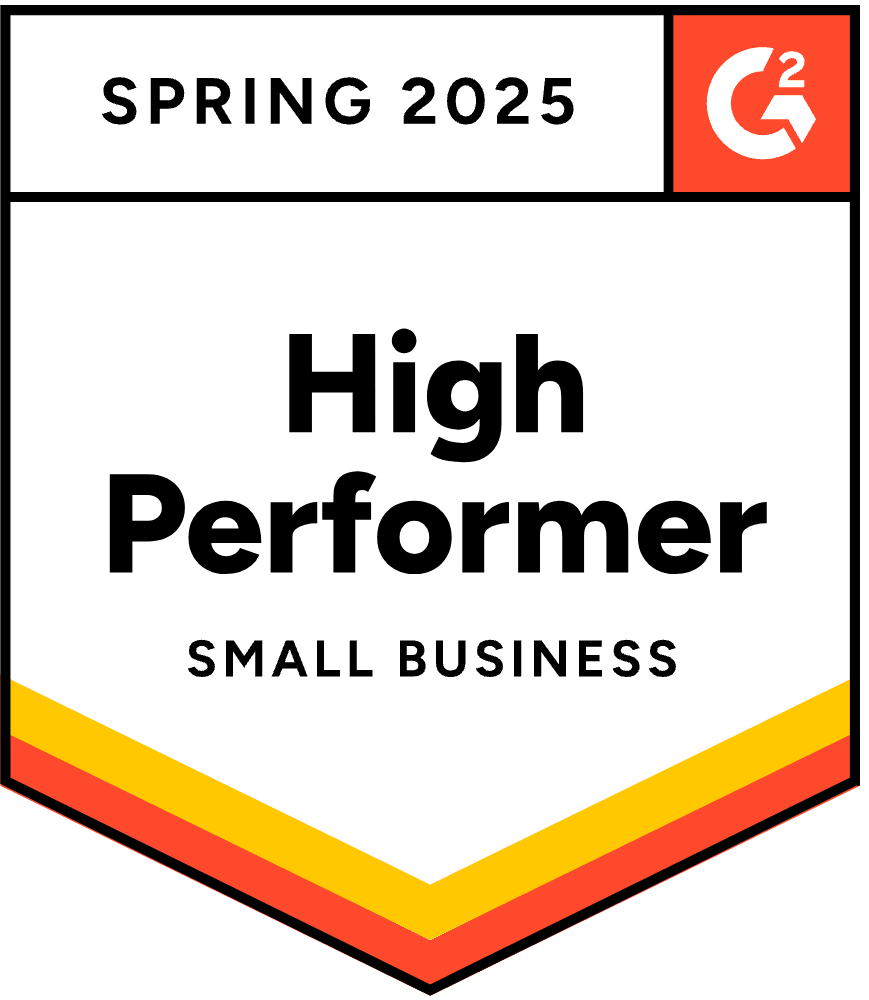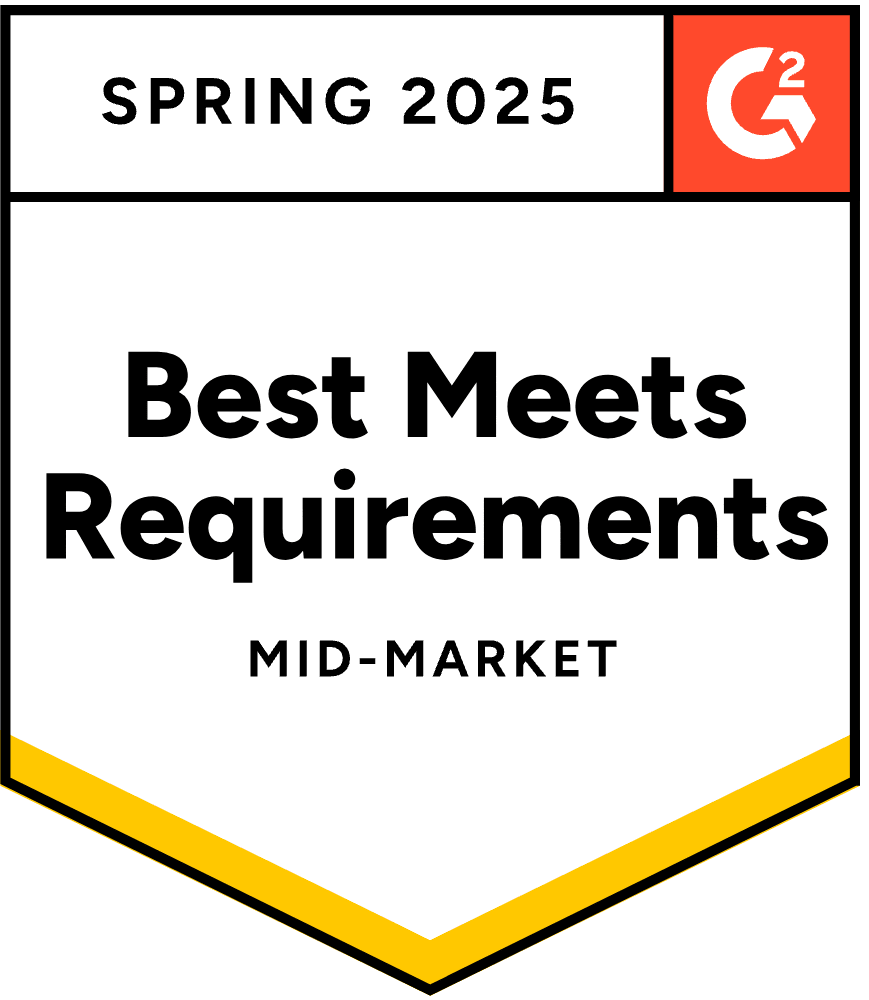- Blog
- 43-Point Ecommerce CRO Checklist to Boost Conversions in 2026
43-Point Ecommerce CRO Checklist to Boost Conversions in 2026
Table of Contents
Tired of “growth hacks” that never actually move the needle? If you’re here, you’re likely looking for CRO strategies that are grounded in data, tested by real brands, and ready to deploy.
We’ve gathered 43 of the most effective, conversion-boosting tactics for your online store, complete with examples and explanations. No fluff—just a roadmap to stronger results.
43-point conversion rate optimization checklist to bring you real results
Here are 43 proven CRO strategies that drive real, measurable results for your ecommerce store—let’s dive in!
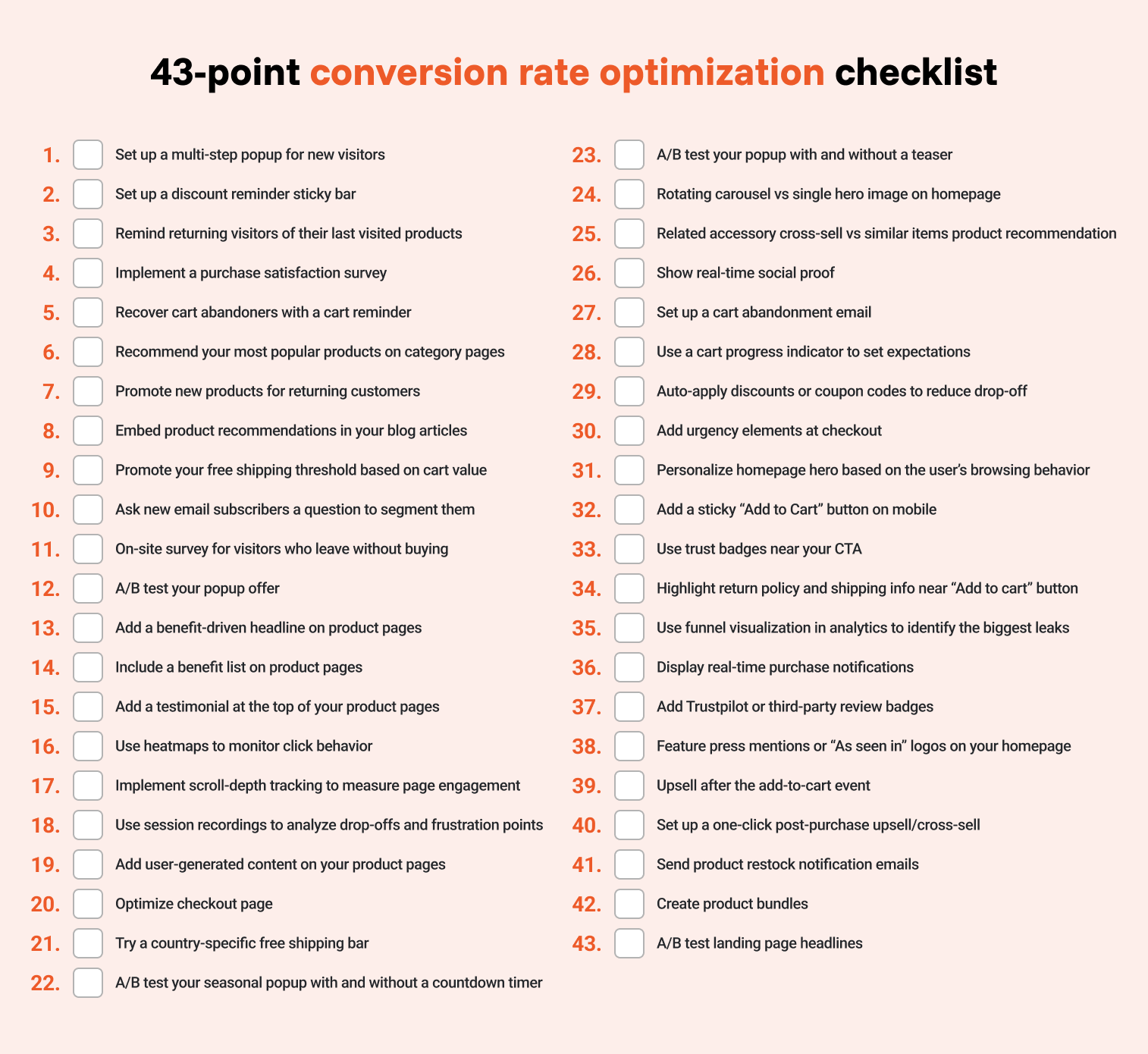
1. Set up a multi-step popup for new visitors
Multi-step popups are incredibly effective when it comes to growing your email list.
Instead of overwhelming potential customers with a form right away, they ease them in with a simple yes/no question. This creates a low-friction entry point for new visitors—which feels less intrusive and more engaging—significantly boosting sign-up rates.
A great example of this in action comes from Mott & Bow.
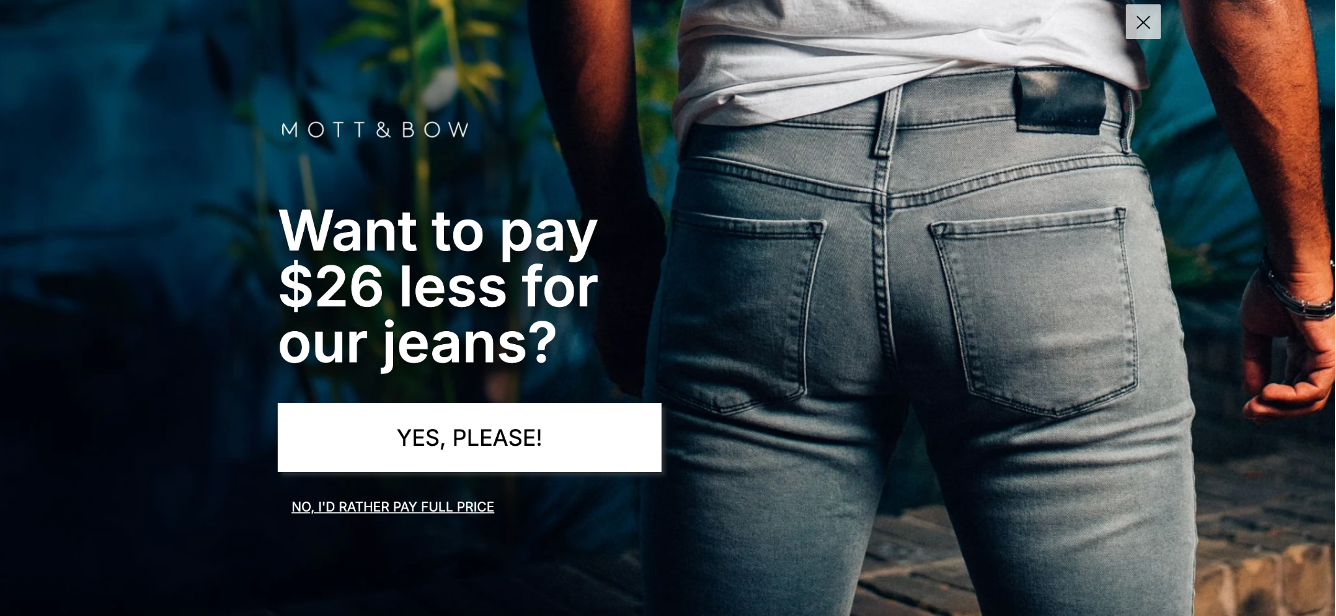
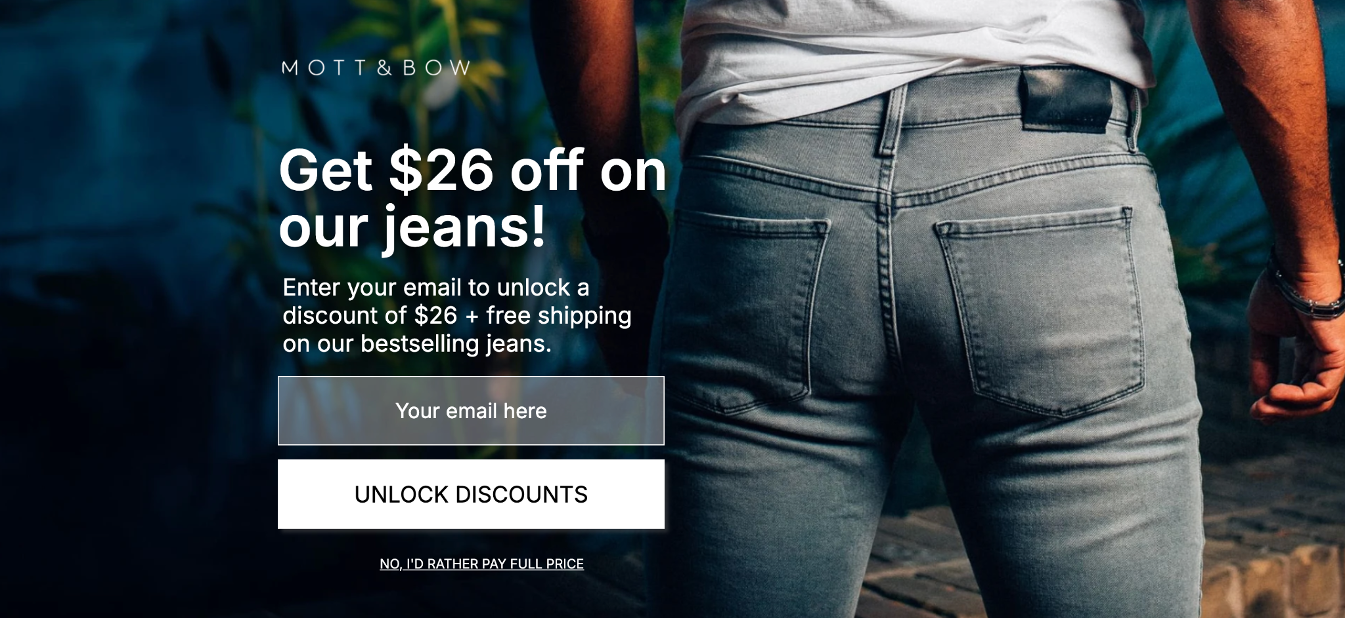
If you’d like to achieve a 10%+ conversion rate with your email popup, follow Mott & Bow’s strategy and try these ready-to-use templates:
2. Set up a discount reminder sticky bar
If you’re giving away discount codes and your customers often forget to use them, here’s an easy fix: add a discount reminder sticky bar.
This tool can boost your coupon redemption rate by at least 50%, serving as a subtle but powerful reminder that ensures visitors don’t forget about their coupon code while browsing.
Check out how Sissora uses a discount reminder at the top of the page:
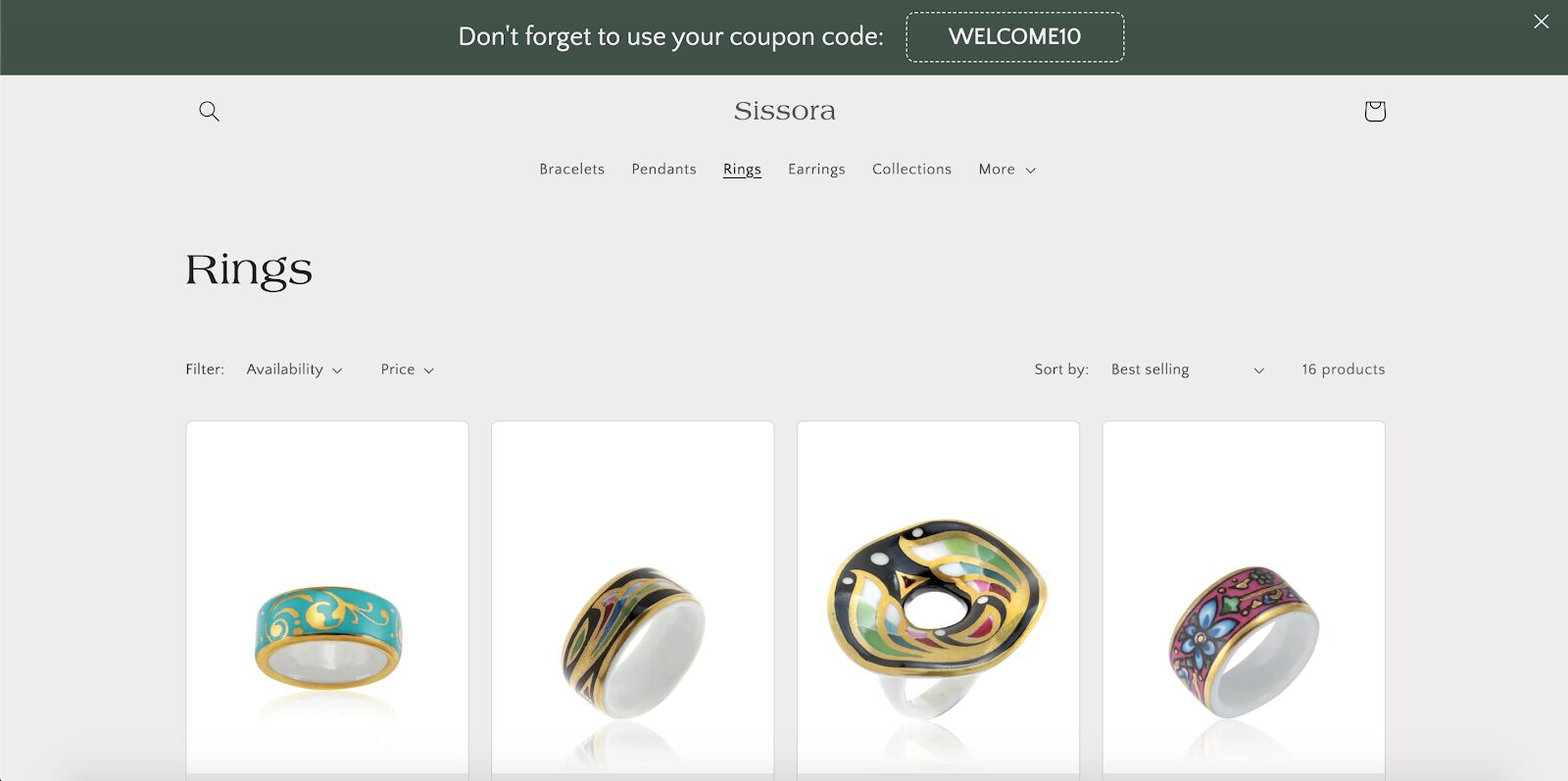
You can get started easily with these pre-made sticky bars:
3. Remind returning visitors about products they viewed last time
Browsing reminder popups are perfect if you’d like to increase your returning visitor conversion rate.
They help re-engage returning visitors by reminding them about products they previously viewed. This creates continuity in the customer journey and rekindles interest, particularly among warm leads.
For example, ParfumeLab’s “Welcome back” popup shows past browsing history, encouraging users to pick up where they left off.
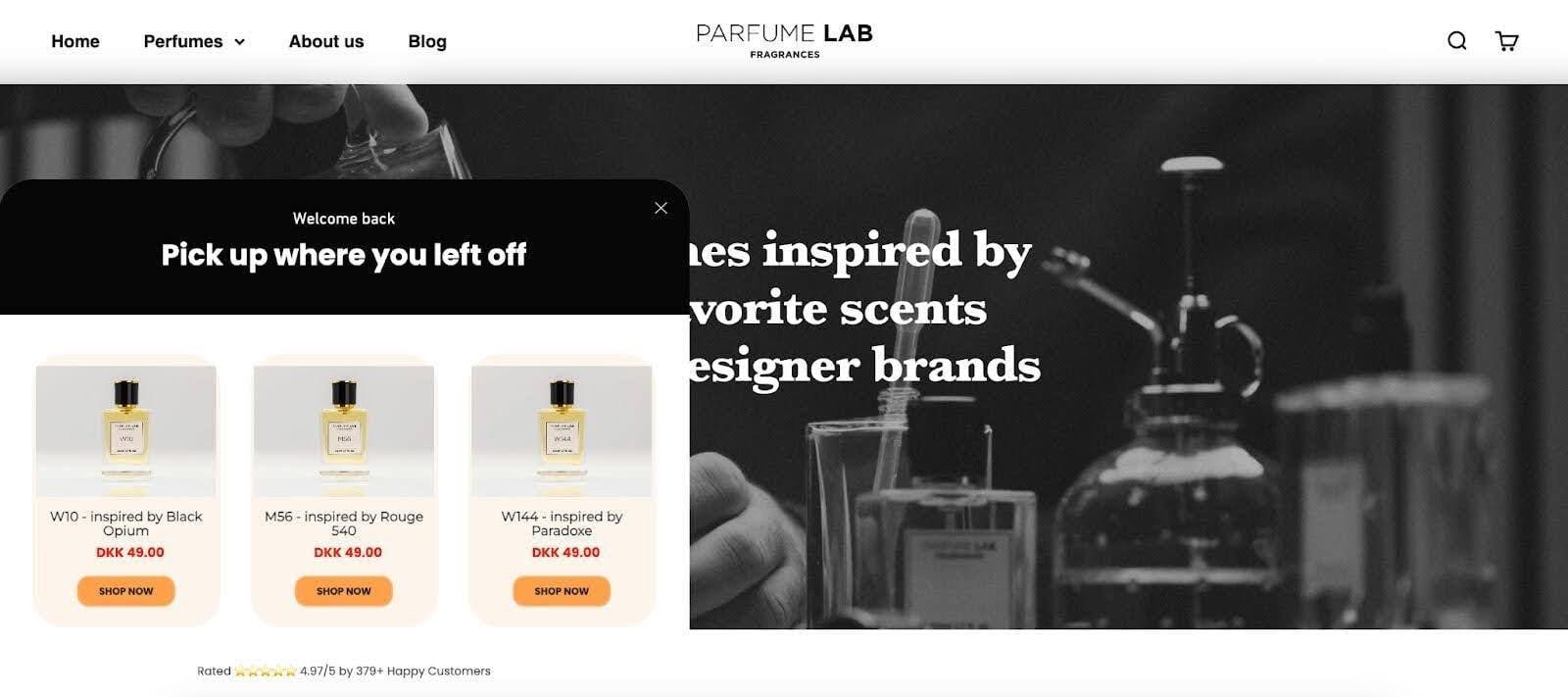
These subtle nudges can drive re-engagement and push visitors closer to a purchase. In fact, ParfumeLab increased returning visitor sales by 19%. If you’d like to achieve similar results, try these templates now:
4. Implement a purchase satisfaction survey
A quick satisfaction survey right after a purchase provides invaluable feedback on the buying experience. This is your best opportunity to capture raw, honest insights when the interaction is still fresh in the customer’s mind.
Follow Amazon’s lead by requesting detailed feedback from your customers.
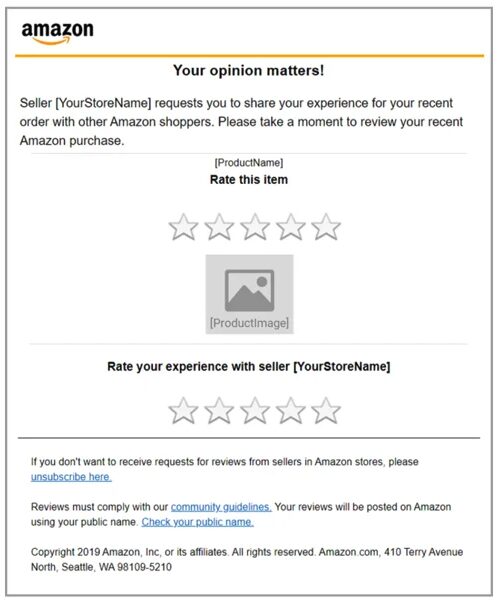
You can use these insights to improve your site, copy, and support, while strengthening customer relationships by showing you care. Make sure to keep it short, conversational, and friction-free.
Here’s a survey template you can use:
5. Recover cart abandoners with a cart reminder
Cart abandonment is one of the biggest challenges for ecommerce store owners. And while it’s inevitable, recovery is possible, and it doesn’t have to be hard.
A well-timed exit-intent popup reminding users about their incomplete purchase can make all the difference.
Keep your message short, friendly, and focused—just like Gelpro did in the example below.
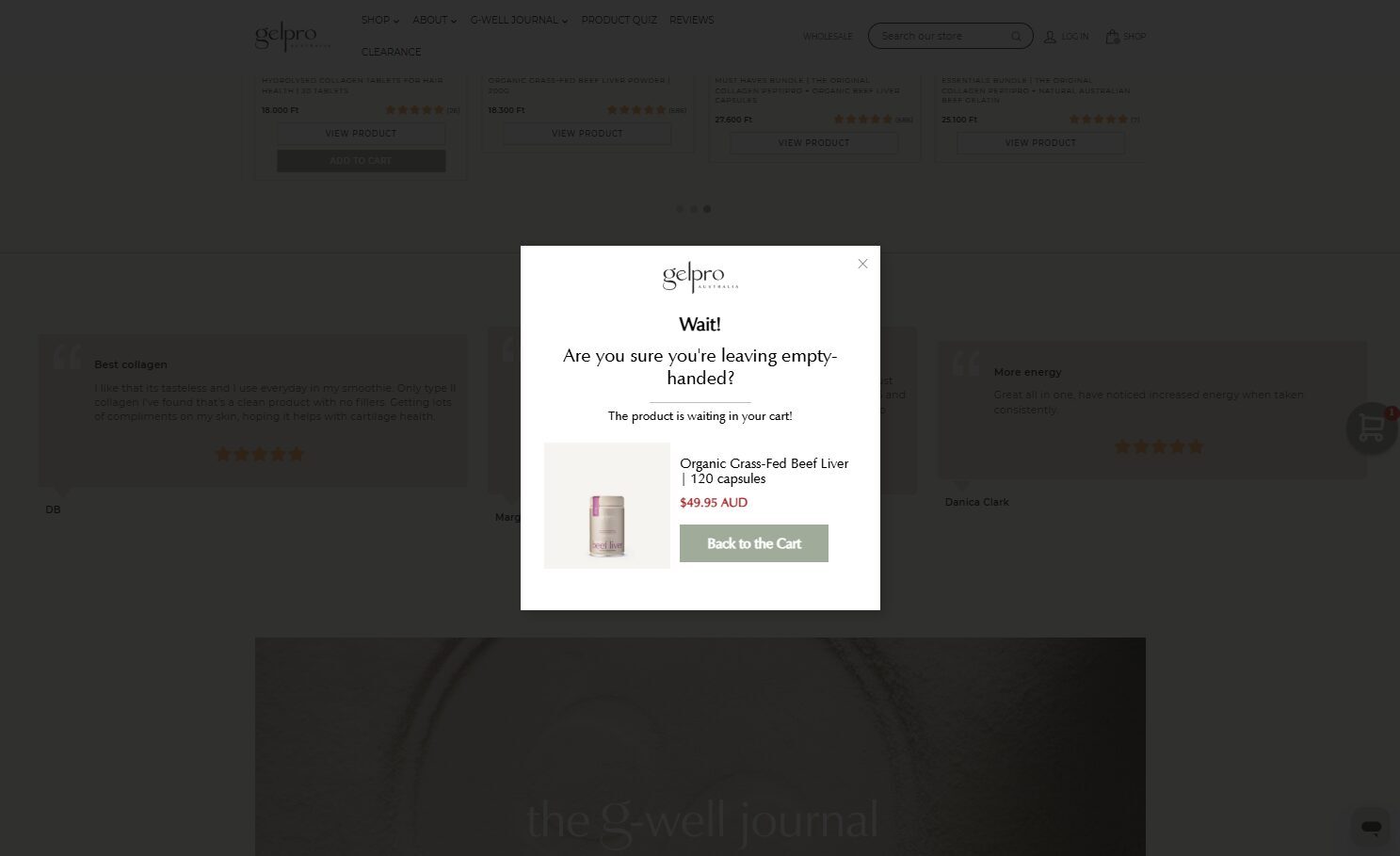
This strategy can decrease your cart abandonment rate by at least 10%, so it’s certainly worth a try:
6. Recommend your most popular products on category pages
Category pages can easily overwhelm shoppers with too many options—a phenomenon explained by the paradox of choice theory. Fewer, more curated options can simplify decisions and boost satisfaction.
Highlighting your best-selling products helps steer customers toward trusted favorites, reinforcing social proof, building trust, and minimizing decision fatigue.
Here’s an example from Olaplex that highlights popular products on their category page:
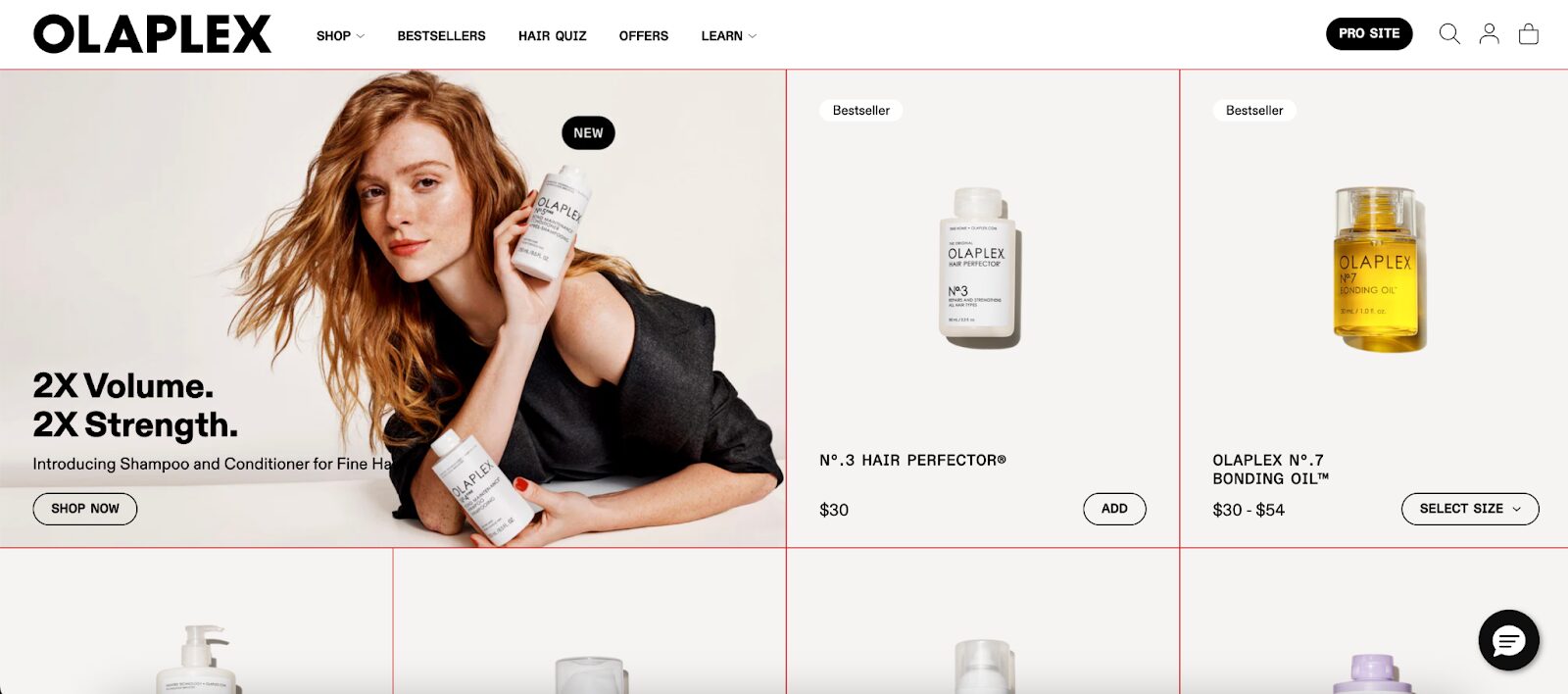
You can also use sticky bars to highlight your bestsellers.
7. Promote new products for returning customers
Returning customers are already familiar with your brand, which means they’re more likely to convert again—if the offer is relevant.
Check out how Gymshark highlights new arrivals on its homepage:
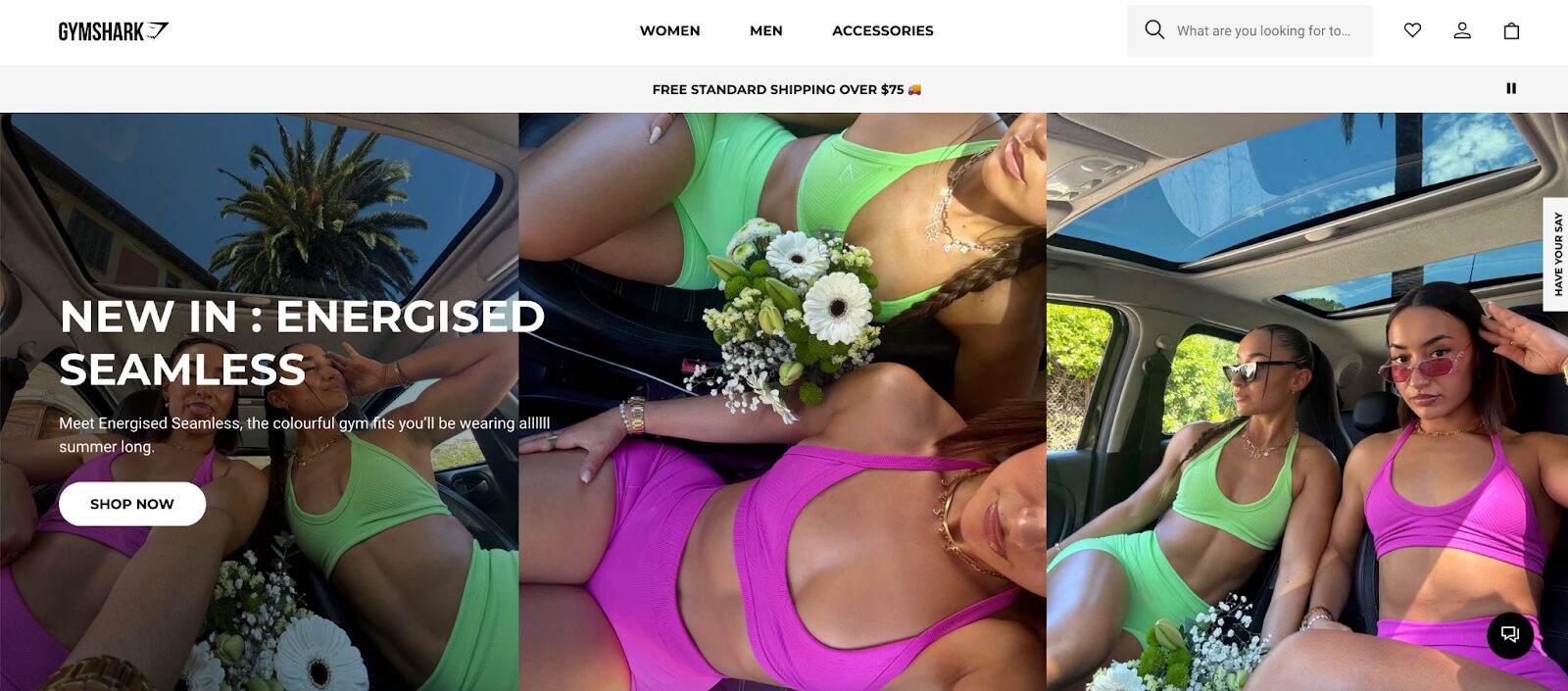
Or you can follow Vegetology’s lead and spotlight new arrivals on a popup with a special discount:
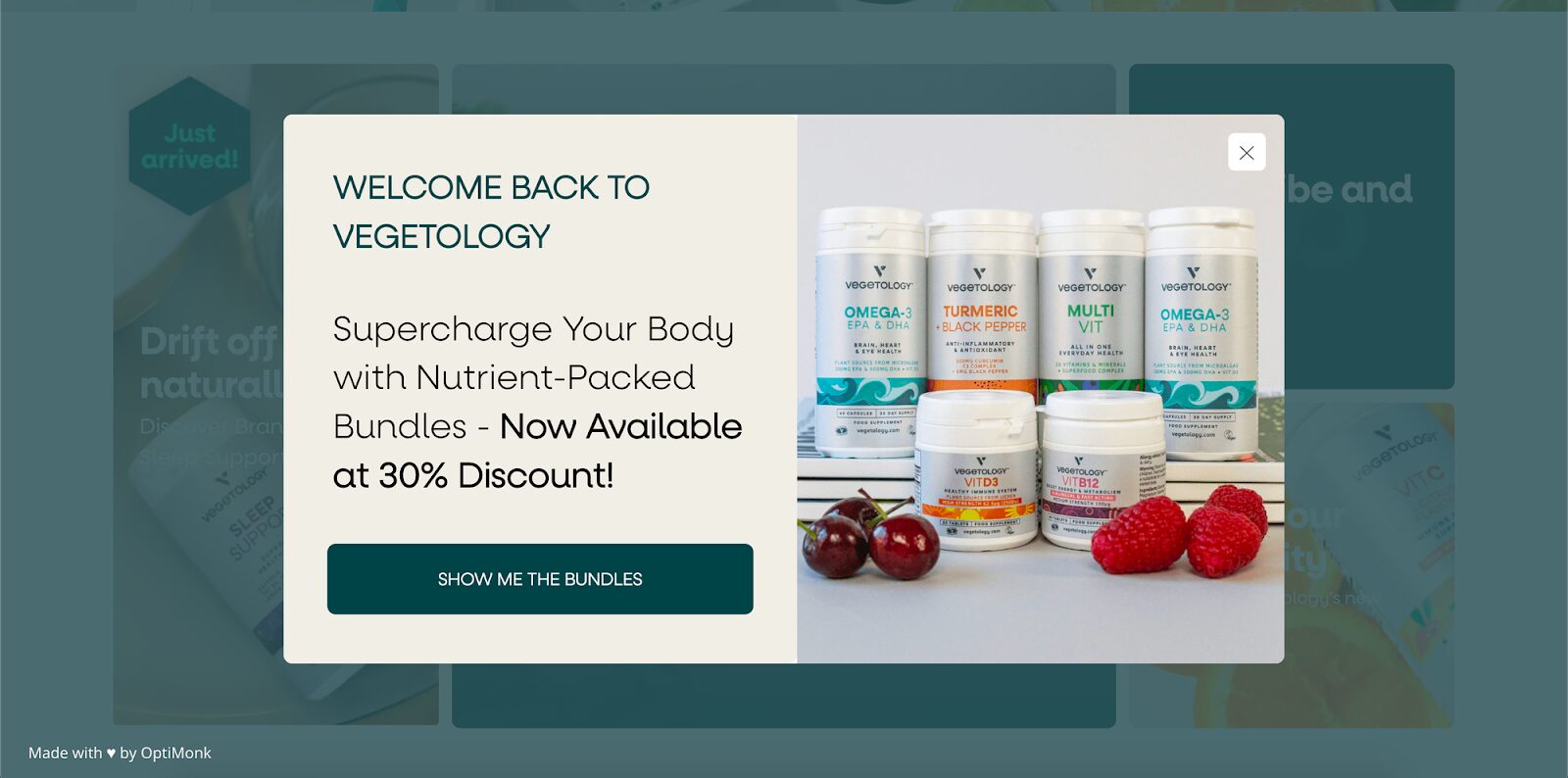
This not only drives conversions but also increases brand loyalty.
8. Embed product recommendations in your blog articles
Your blog is a powerful tool for driving organic traffic, but it can do much more—it can actively drive conversions.
Embed relevant product recommendations directly into your content to transform passive readers into buyers.
When someone lands on your article from a search engine, they’re already interested in the topic. If you recommend a product that naturally fits the content, it feels helpful rather than pushy.
For example, a post about skincare routines could include links to your top-selling moisturizers or serums.
Here’s a real-world example that shows Bearaby integrating product recommendations into their blog posts:
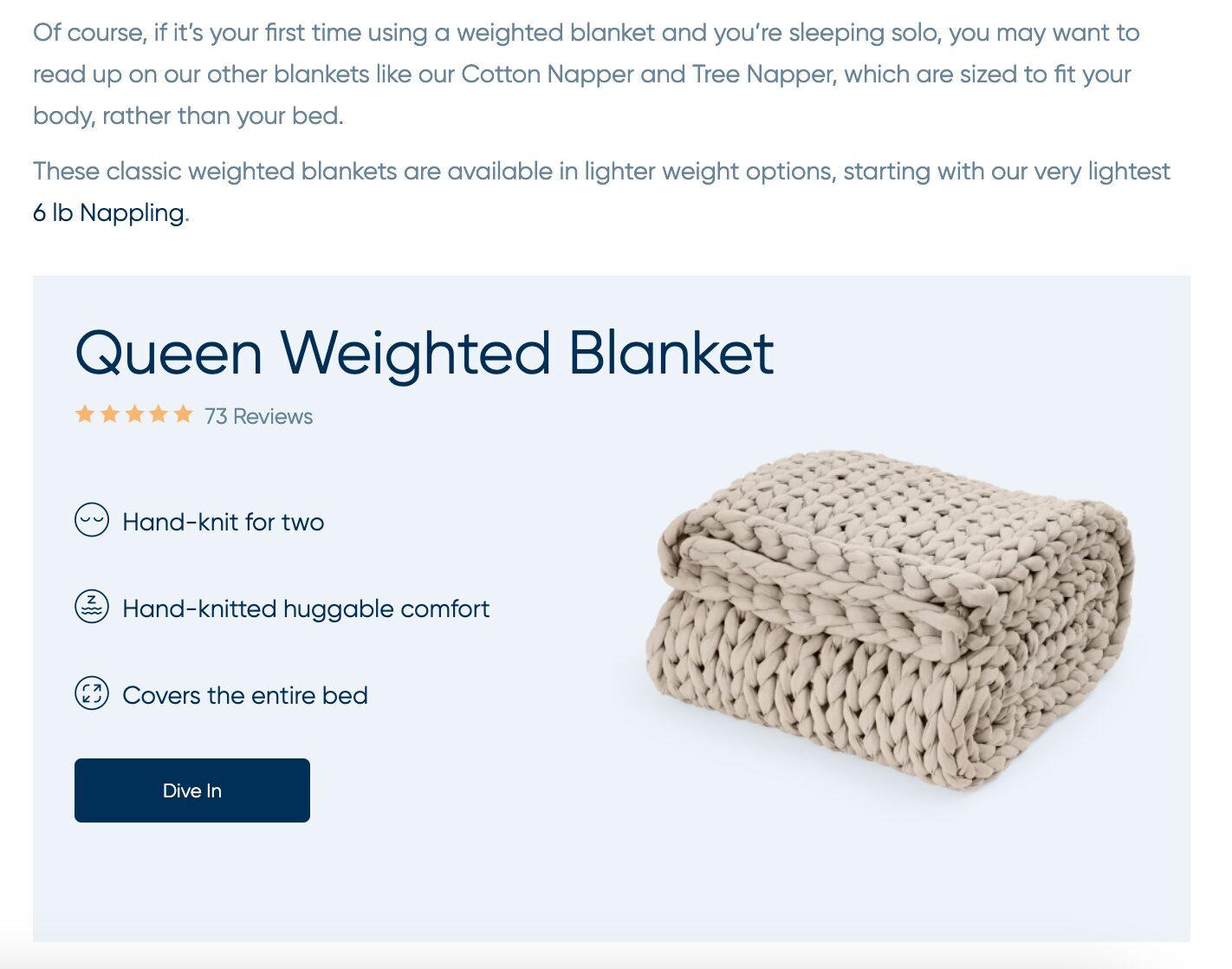
And here’s another example from Caraway:
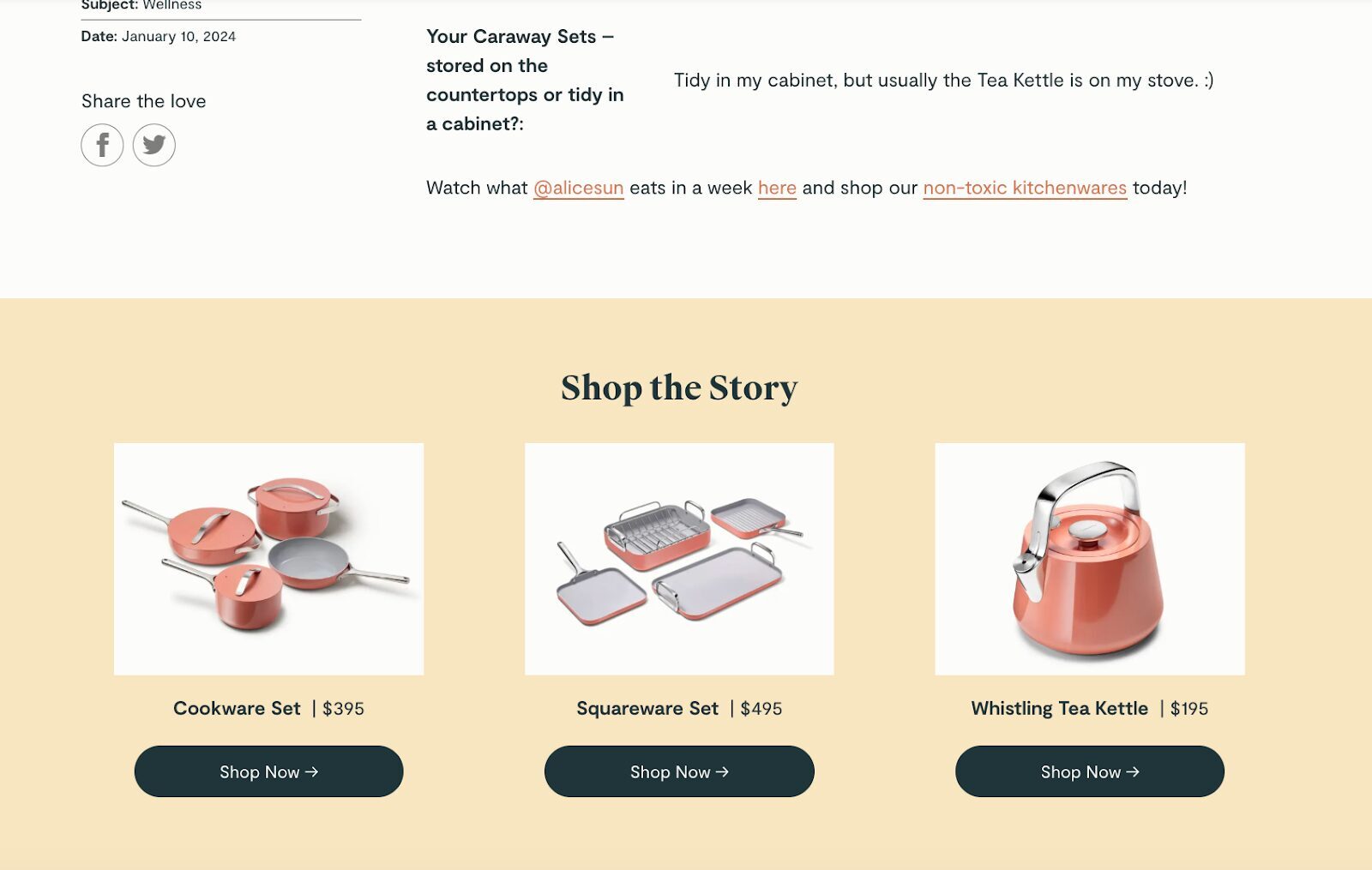
Keep recommendations relevant to avoid a salesy feel. Do it right, and you’ll boost engagement, cart value, and session time.
9. Promote your free shipping threshold based on cart value
66% of consumers expect free shipping on all online purchases. In fact, free shipping can increase retailer sales by up to 10%. And by using a dynamic free shipping bar, you can also motivate shoppers to add more to their carts.
Display a dynamic sticky bar that tells users exactly how much more they need to spend to unlock this coveted perk.

This tactic not only drives higher order values but also reduces cart abandonment. It’s a simple adjustment with significant upside.
Get started with OptiMonk’s ready-to-use templates and use our Smart Tags feature to set it up quickly.
10. Ask new email subscribers a question to segment them
Not all visitors are the same, so if you want to increase conversions, don’t treat them all the same!
Asking a simple question or two when someone joins your email list is an easy way to segment your audience and send personalized messages.
Use a multi-step popup to capture segmentation info before requesting an email address. Whether it’s “What are you shopping for today?” like in the example below from Christopher Cloos, or something like “What’s your biggest challenge?”—this one step gives you valuable insight into their interests and intent.
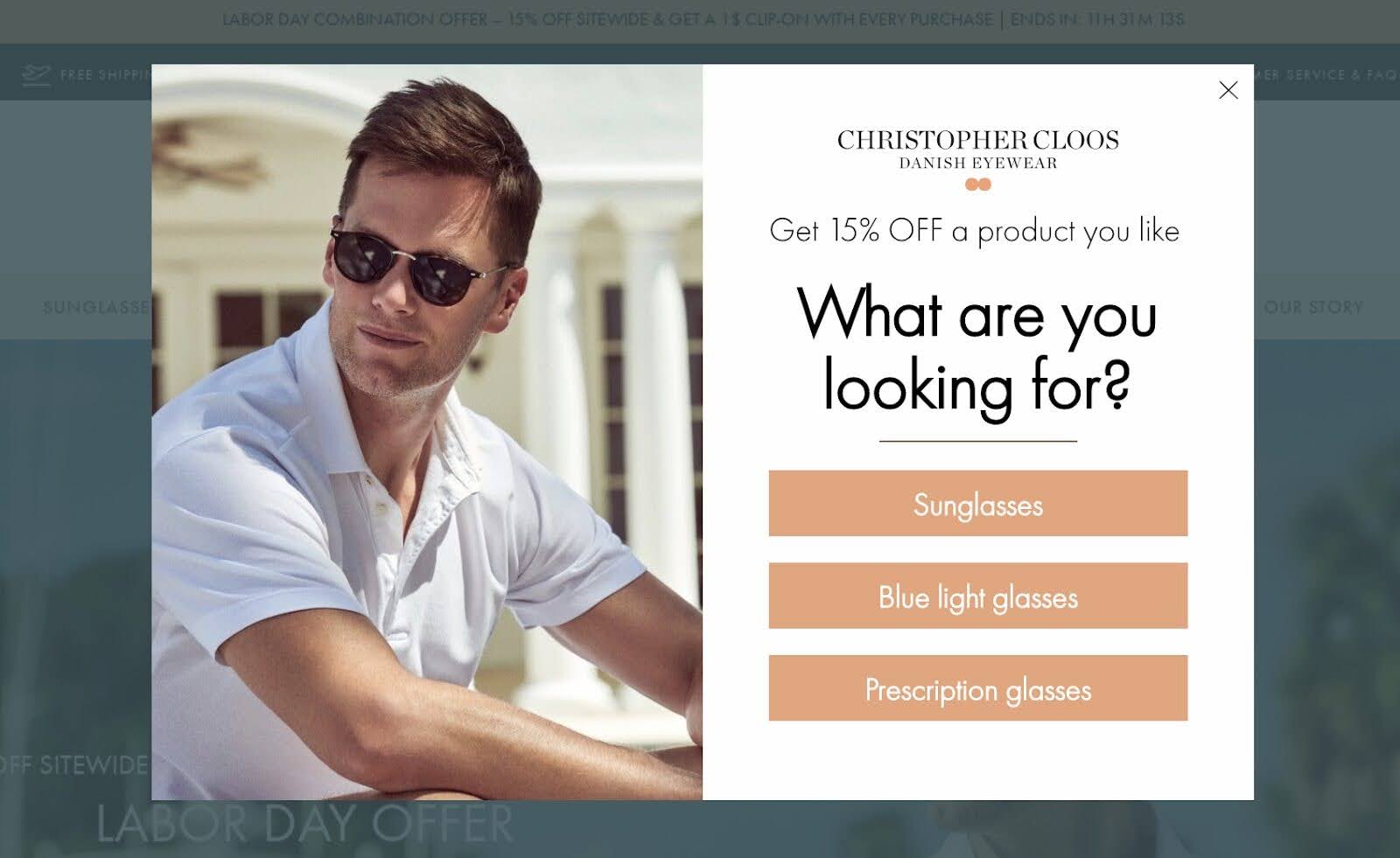
This allows you to tailor future emails based on interests or demographics, improving click-through and conversion rates.
Get started with OptiMonk’s conversational popups.
11. Try an on-site survey for visitors who leave without buying
Understanding why a potential customer didn’t buy is just as important as knowing why another did. An on-site exit survey helps capture feedback from visitors who are about to leave without completing a purchase.
Ask a simple question like “What stopped you from buying today?” to uncover objections, confusion, or issues you might not have considered. You can make it easy with multiple-choice responses (like in the example below) or you can turn it into an open-ended question.
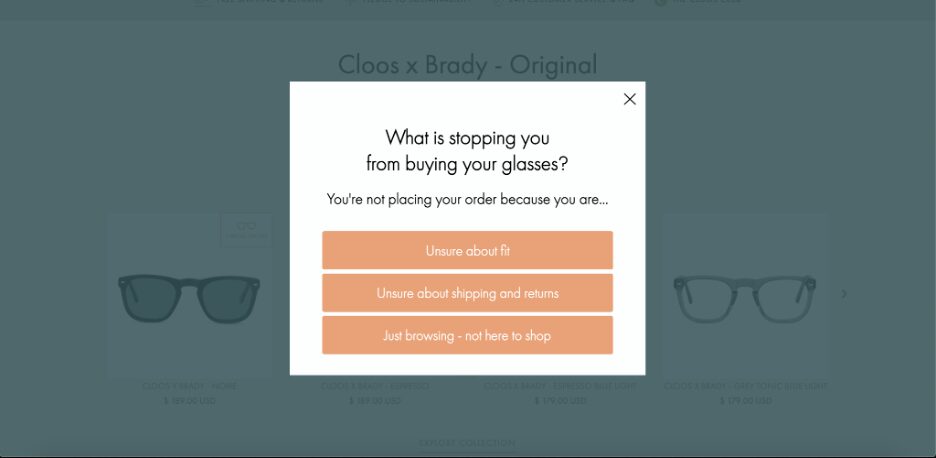
But don’t just collect feedback—make sure to learn from it, as it can guide product improvements, messaging changes, or UX optimizations.
12. A/B test your popup offer
Different offers appeal to different audiences, and the only way to know what works for your audience is to test.
A/B testing your popup offers—whether it’s a percentage discount, a dollar amount, a mystery deal, or free shipping—helps you find the incentive that resonates most.
You might discover that a mystery discount outperforms a flat 10% offer simply because it piques curiosity.
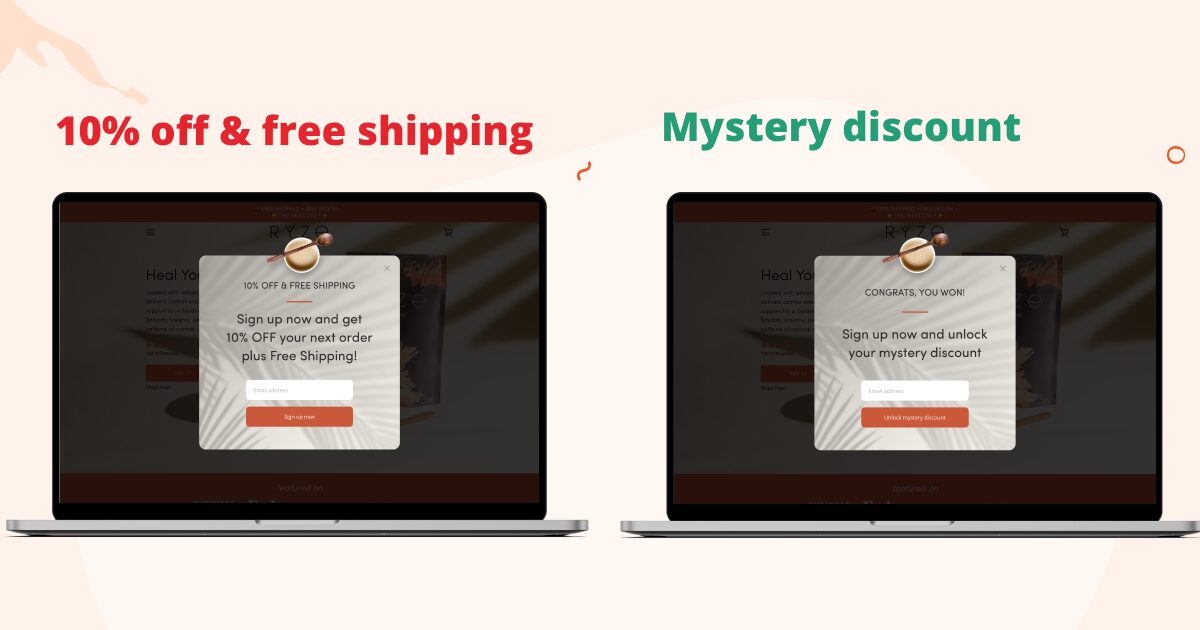
Or maybe a free gift drives more engagement than a dollar-off deal. The key is to let real user data guide your decisions rather than relying on assumptions.
With OptiMonk, it’s extremely easy to A/B test your offer. Just duplicate your campaign, make the necessary changes in your popup, then activate both versions and see which one drives more conversions. Find detailed setup instructions here.

13. Add a benefit-driven headline on product pages
According to stats, storytelling increases the perceived value of a product by up to 2,706%. So product pages need to do more than list features—they need to sell a feeling, a result, or a transformation.
A benefit-driven headline helps immediately answer the customer’s biggest question: “What’s in it for me?”
Instead of just naming the product, highlight how it improves their life, saves time, or solves a pain point.
Check out how Varnish & Vine added a unique slogan for each product, a benefit-driven headline, and a list of main benefits. With these changes, they increased their revenue by 43%.
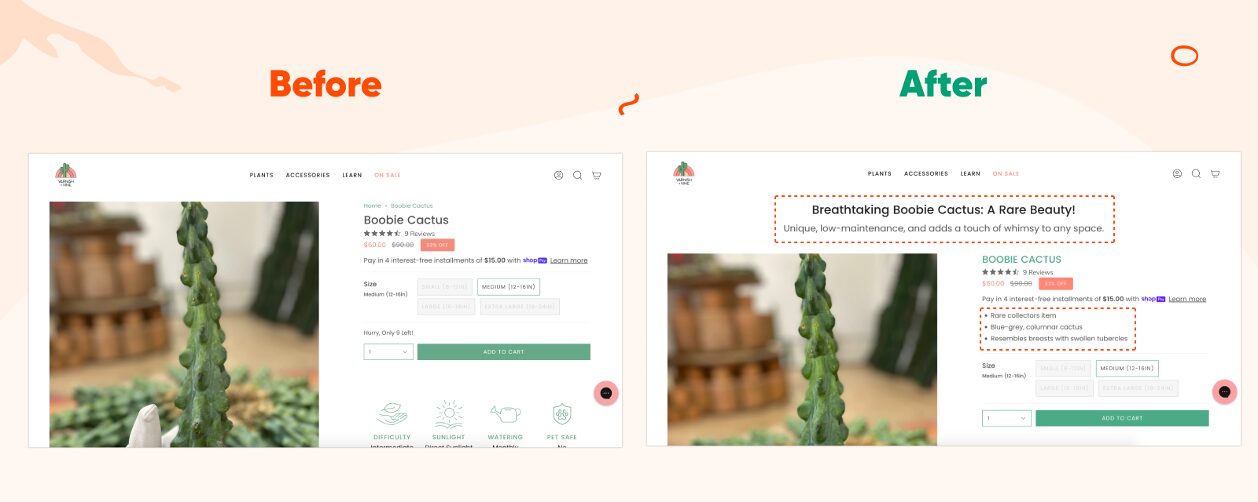
Benefit-driven headlines establish emotional relevance and can significantly improve conversion rates.
Optimizing dozens or even hundreds of product pages manually can be challenging, but OptiMonk’s AI-powered Smart Product Page Optimizer tool makes it simple.
Learn more about how it works here.
14. Include a benefit list on product pages
Beyond the headline, your product page should clearly explain why someone should care about the item.
A concise benefit list turns features into user-centric outcomes, telling the shopper exactly how the product will make their life easier, better, or more enjoyable.
Use bullet points or short statements to break down each core benefit in simple, relatable terms.
For example, Muscle Feast includes visually clean lists that drive home product value without overwhelming the user.
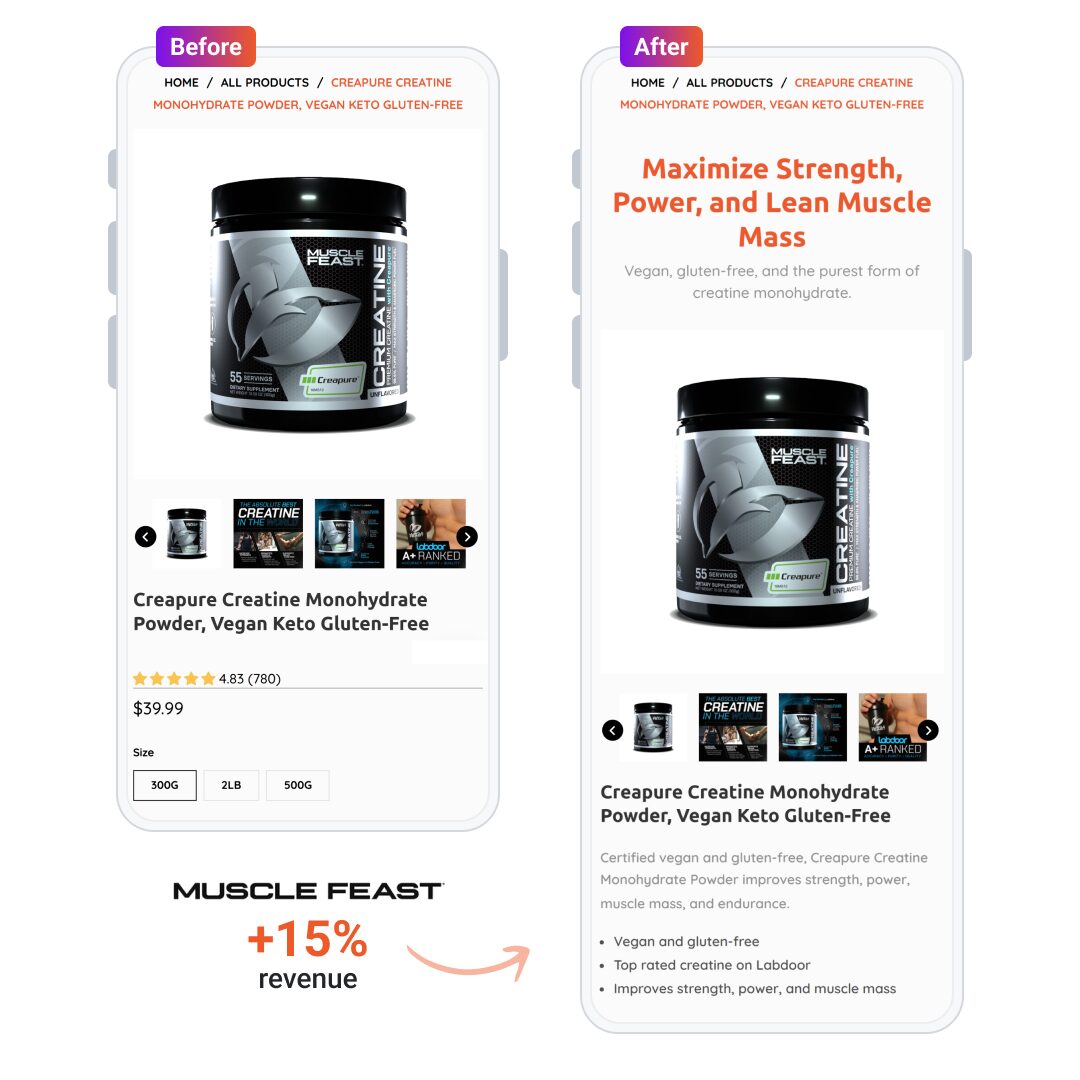
15. Add a testimonial at the top of your product pages
Testimonials and other trust-building elements can improve conversion rates by up to 42% in ecommerce.
Placing a testimonial above the fold creates instant credibility. When users land on a product page and immediately see positive feedback from another buyer, it reassures them that they’re making a smart choice.
This is especially powerful for first-time visitors who may be unfamiliar with your brand.
Vegetology uses this approach by featuring short but persuasive testimonials early on the page. It’s a small tweak that adds an important layer of trust. This strategy increased Vegetology’s conversion rates by 6%.
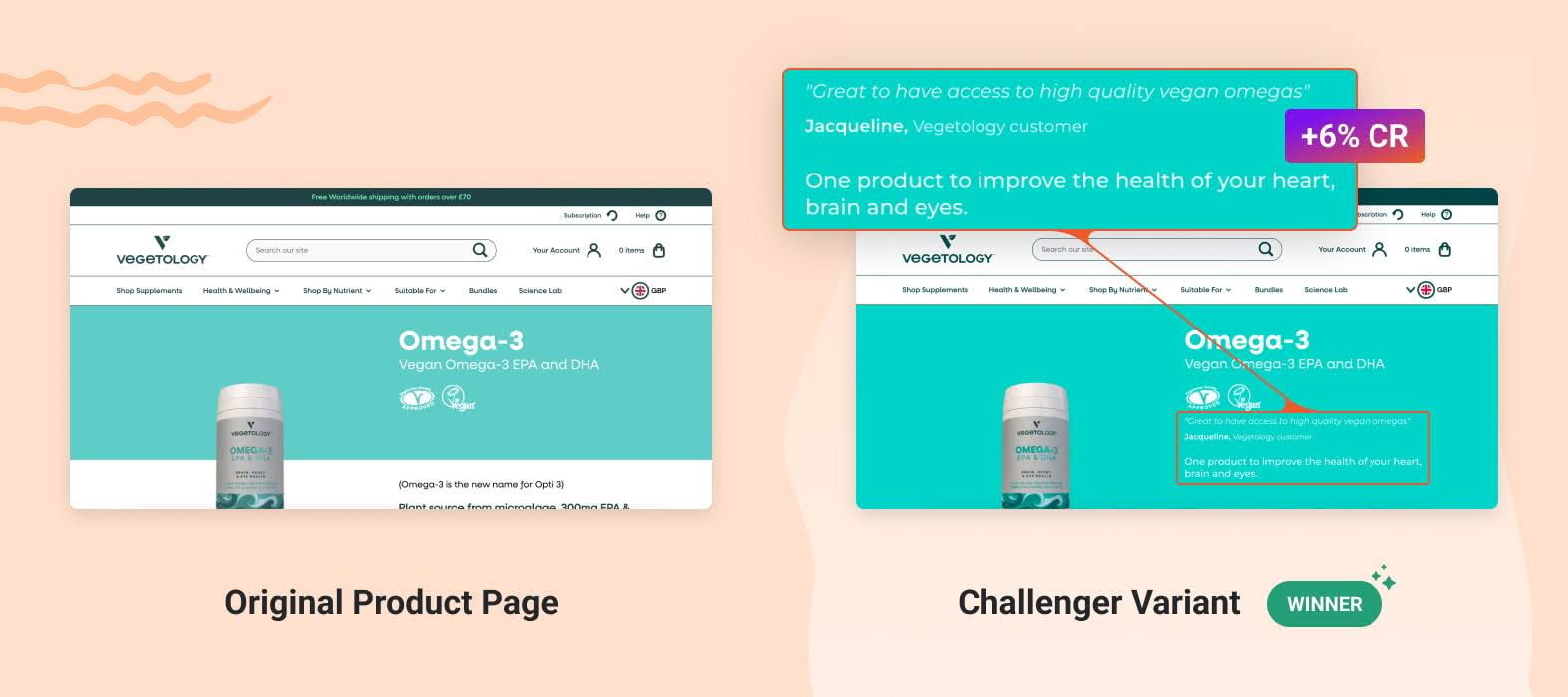
16. Use heatmaps to monitor click behavior
Heatmaps visually show where users click, scroll, or hover on your site, offering a bird’s-eye view of engagement.
This helps you understand which areas attract attention and which are being ignored. Are people missing your main CTA? Are they getting distracted by unnecessary links?
With tools like Hotjar, Crazy Egg, or Microsoft Clarity, you can identify pain points and optimize layouts for better flow. It’s an essential tool for making data-backed UX decisions.

17. Implement scroll-depth tracking to measure page engagement
You can also track scroll depth using the same tool you use for heatmaps.
Knowing how far users scroll gives you insights into content engagement. If only a small percentage of visitors reach your CTA or product description, you might need to adjust the layout or messaging.
Scroll-depth tracking helps you pinpoint where interest drops off so you can make changes that keep users engaged.
It’s a quick, efficient way to gauge content performance without relying solely on bounce rates. The deeper users scroll, the more your content holds their attention—and the more likely they are to convert.
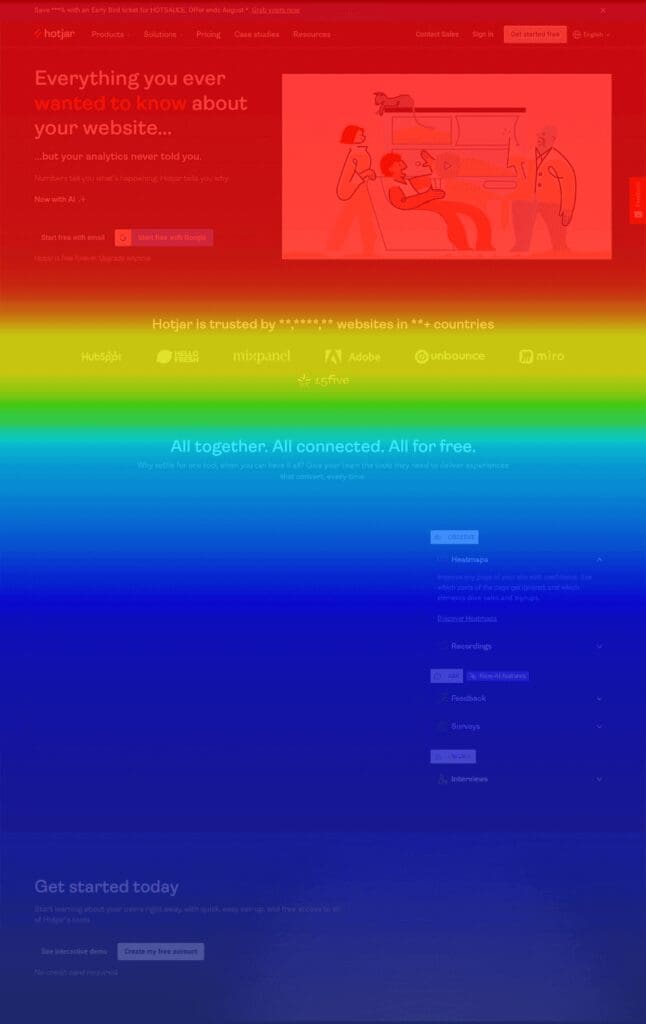
18. Use session recordings to analyze drop-offs and frustration points
While analytics show you what’s happening, session recordings show you why. Watching how users interact with your site in real time—where they click, hesitate, or rage-click—can reveal critical usability issues.
You might notice visitors struggling with navigation, getting stuck in loops, or abandoning forms due to poor design.
These recordings help identify and fix UX flaws that numbers alone can’t explain. It’s like usability testing at scale.
19. Add user-generated content on your product pages
User-generated content (UGC), like customer photos or reviews, adds a layer of authenticity that polished product images often lack. It shows real people using your product in real-life scenarios, which builds trust and reliability.
Brands like Kylie Cosmetics include UGC on product pages to foster community and boost buyer confidence. This content also increases time on site and can help reduce return rates.
When customers see others enjoying the product, they’re more likely to click “Add to Cart.”
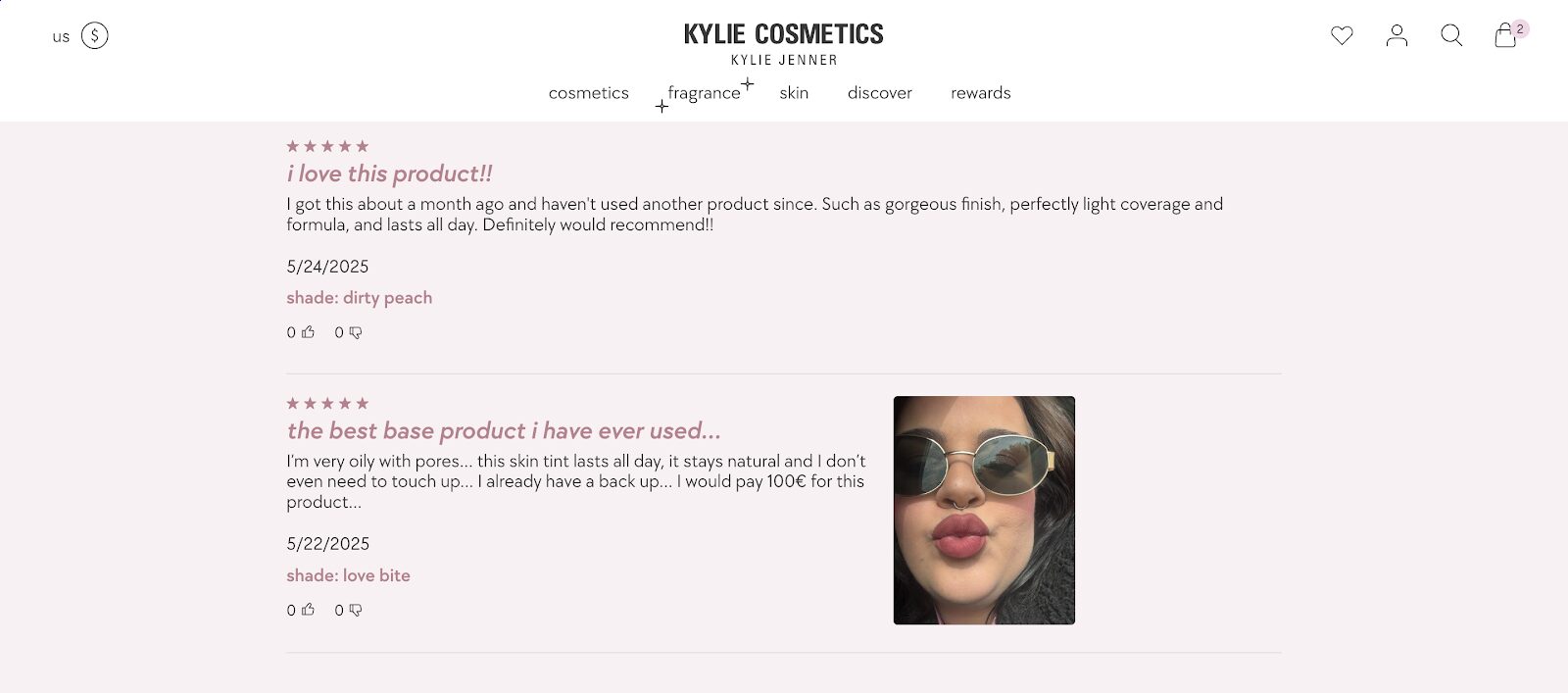
20. Optimize your checkout page
A long, complicated checkout process is one of the top reasons for cart abandonment. In fact, 17% of cart abandoners leave because of issues with checkout.
Streamlining the process by removing unnecessary fields, enabling autofill, and offering guest checkout can have a big impact on your conversion rates.
Allbirds, for example, uses a simplified checkout that focuses on speed and clarity:
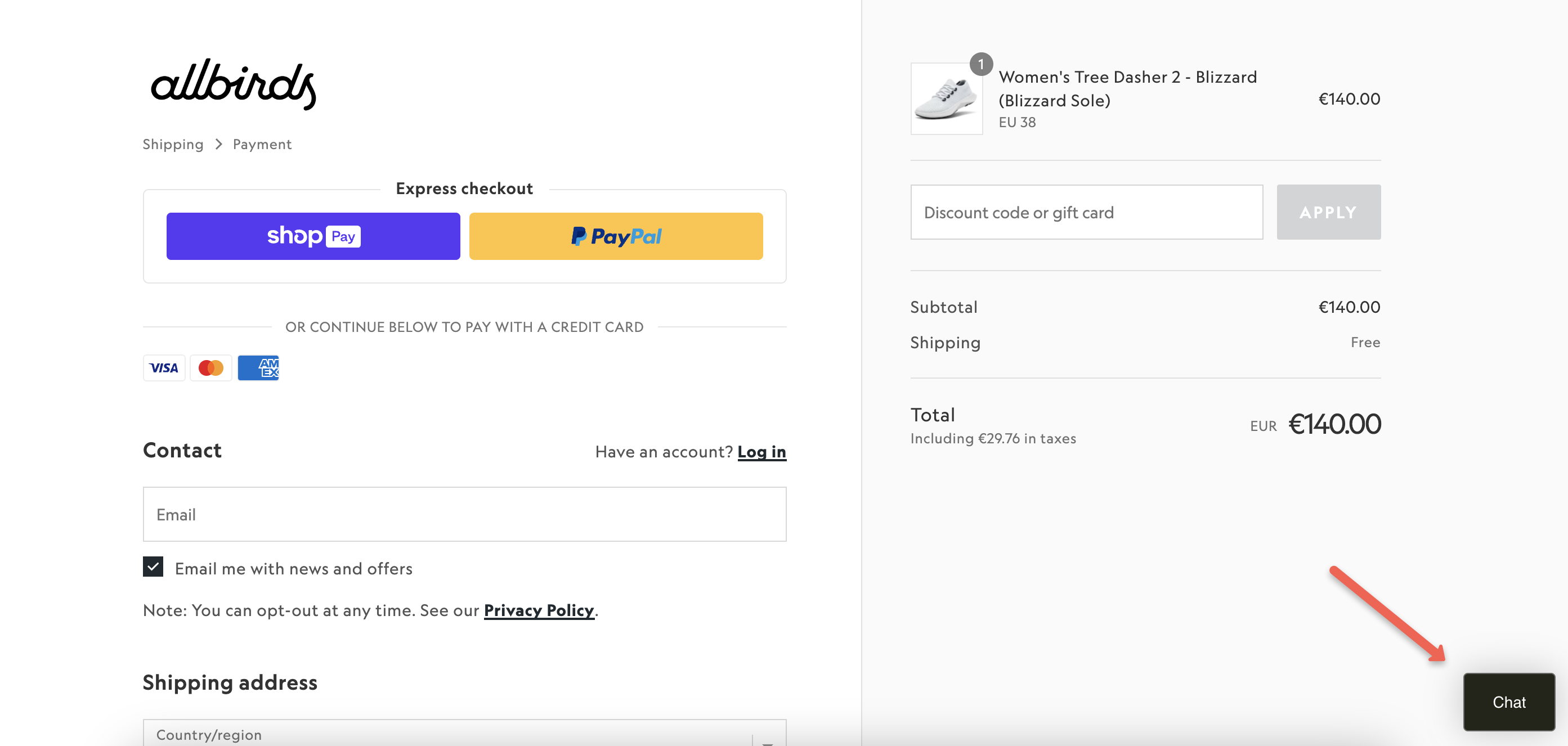
Every second counts, so make it effortless for users to convert.
Recommended reading: 16 Ecommerce Checkout Best Practices to Optimize Yours
21. Try a country-specific free shipping bar
A generic “free shipping” message can create confusion, especially for international visitors. Tailor your free shipping bars to reflect accurate, country-specific thresholds and messaging. This avoids disappointment and sets clear expectations.
Check out this example from Khy. They use a region-based shipping bar that dynamically updates based on user location.

Learn how you can personalize your shipping bars based on location with OptiMonk.
22. A/B test your seasonal popup with and without a countdown timer
Countdown timers add urgency, but do they always work? Not necessarily.
A/B testing your seasonal popup with and without a timer is a great conversion optimization strategy to determine if the added urgency motivates action—or causes unnecessary pressure.
In some cases, a clean design and value-driven offer may outperform a time-sensitive one.
Get started with this template to see how your seasonal campaign fits your audience’s behavior and mindset:
23. A/B test your popup with and without a teaser
Teasers can serve as a pre-engagement element or as a follow-up reminder after a popup is closed.
Here’s an example from Lemme that appears after a user closes their popup without converting:

While these small teasers usually improve conversions, it’s worth testing versions of your campaign with and without the teaser to really understand whether it increases engagement or simply adds clutter.
When used effectively, a teaser builds curiosity and can lead to higher conversions over time. It’s a subtle tactic, but one worth experimenting with.
Data will tell you whether your visitors prefer a nudge or a clean slate.
Teasers are automatically added to all OptiMonk popups, but you can easily change the settings and the appearance—or remove them all together.

24. A/B test a rotating carousel vs a single hero picture on your homepage
Another great conversion optimization test is experimenting with your homepage hero image.
While rotating carousels may seem visually dynamic, they often result in lower engagement beyond the first slide.
Here’s an example from Berluti, which uses a carousel on its home page:
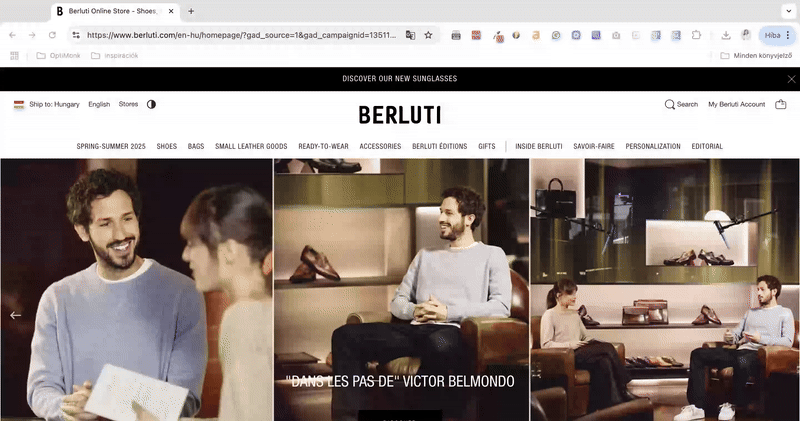
And here’s a static hero image example from Goop:

A strong, static hero image with a compelling CTA might perform better in both clarity and conversion rates.
However, the only way to know what works for your audience is to test both. Pay attention to click-through rates, bounce rates, and scroll behavior for each version.
Simplicity usually wins—but always let the data decide.
25. Experiment with related accessory cross-sells vs similar item product recommendations
Recommending accessories that complement a main product can significantly boost average order value. These suggestions enhance the original purchase, making the customer feel like they’re getting a complete solution.
In contrast, showing “similar items” may cause second-guessing or confusion, potentially leading to abandonment.
Cross-sells should be timely, relevant, and framed as helpful, not salesy.
For example, Lululemon turns a leggings purchase into a “complete look” with recommendations for complementary items.
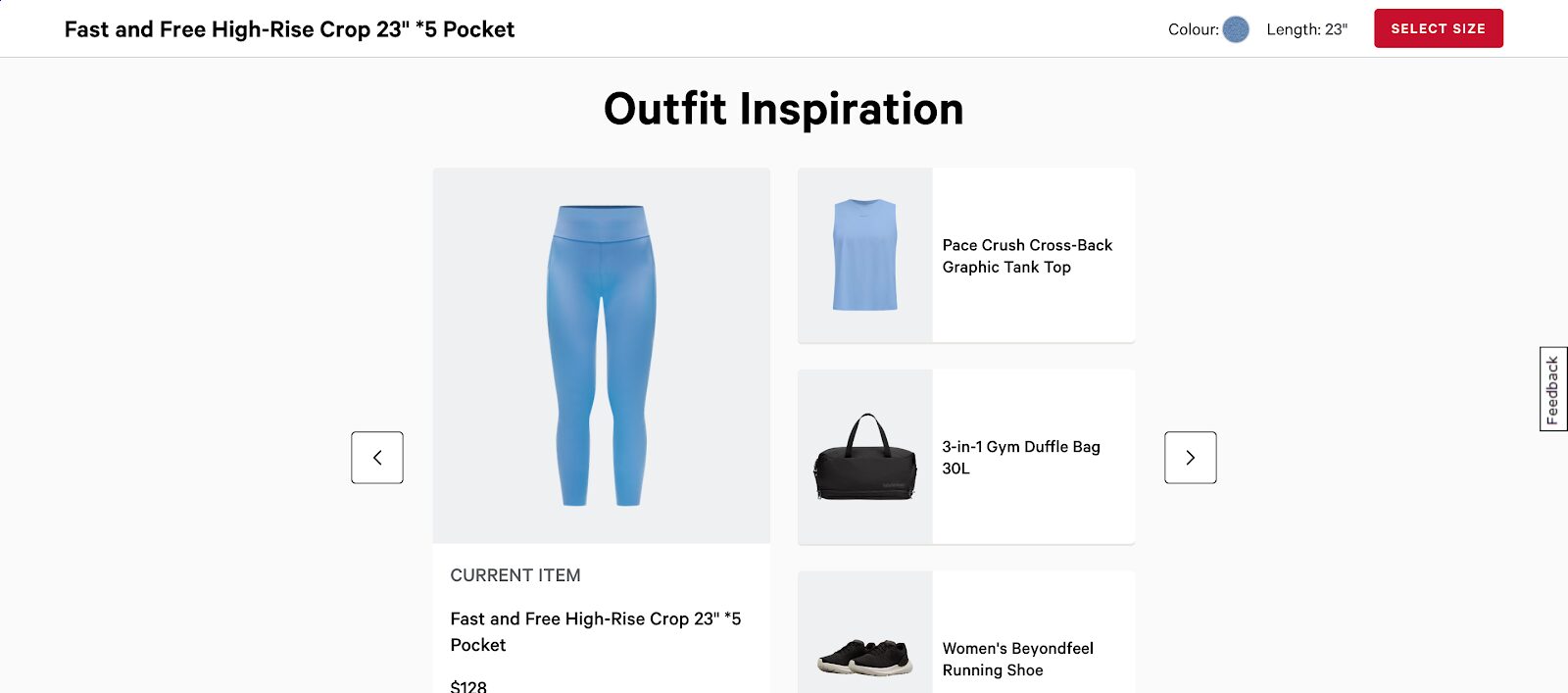
And here’s another example from Luckyscents.com suggesting similar items:

26. Show real-time social proof
Real-time social proof creates a sense of urgency and trust by showing that others are buying right now.
Phrases like “25 people purchased this today” imply demand and popularity, which subtly encourages users to act.
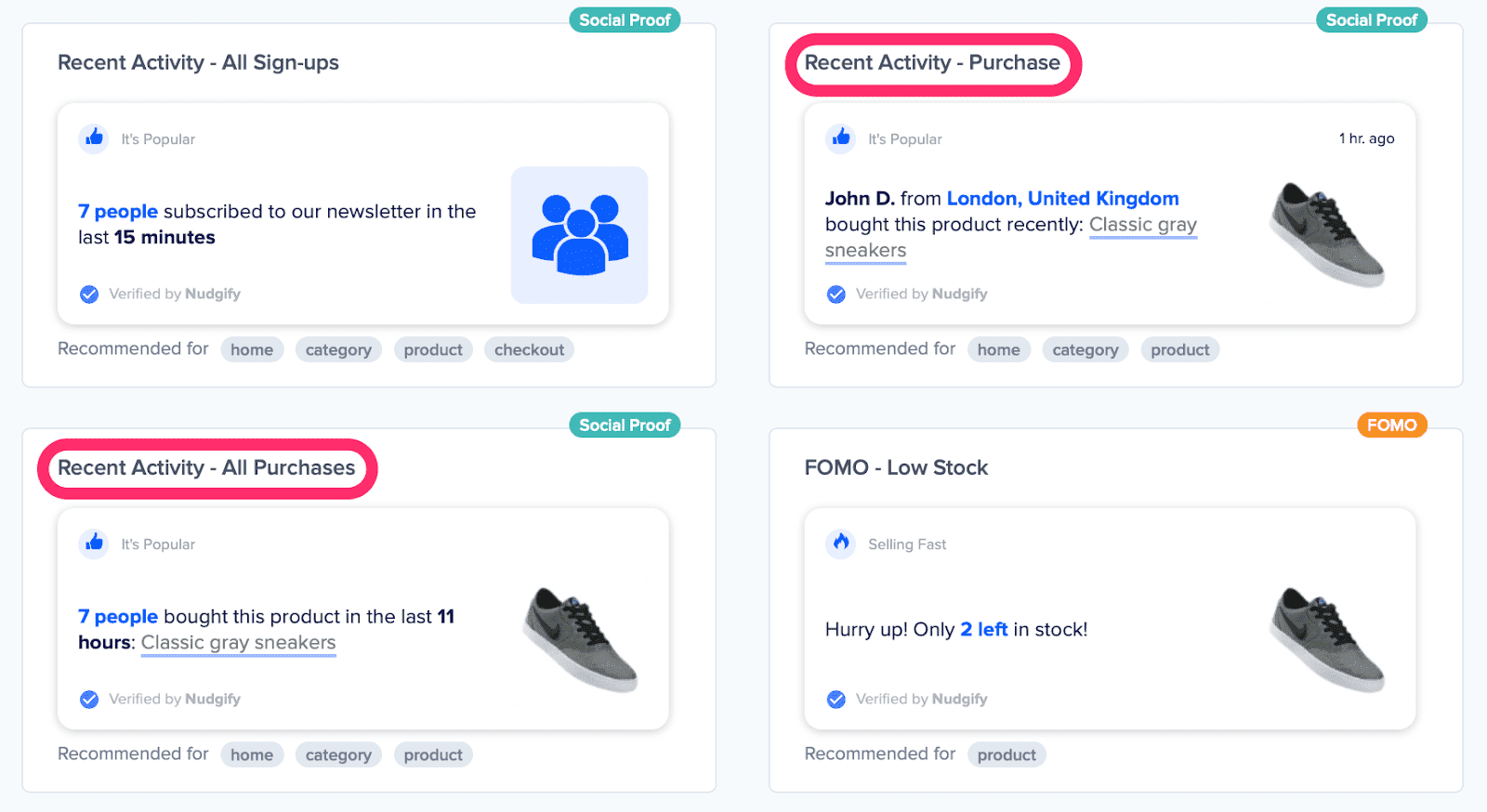
Image source: Nudgify
This technique taps into the psychological principle of conformity—people feel safer making decisions others have already validated.
27. Set up a cart abandonment email
Cart abandonment emails are a low-cost, high-return way to recover lost sales.
Trigger them within an hour, include the abandoned product, add a clear CTA, and consider offering an incentive.
Keep it personal and on-brand—like Casper, who nudges without nagging.

28. Use a cart progress indicator to set expectations
Progress bars are visual cues that show users how many steps remain in the checkout process. This reduces uncertainty and keeps users motivated by giving them a clear path to completion.
A simple three-step indicator like “Shipping > Payment > Review” can lower drop-off rates by minimizing mental load.
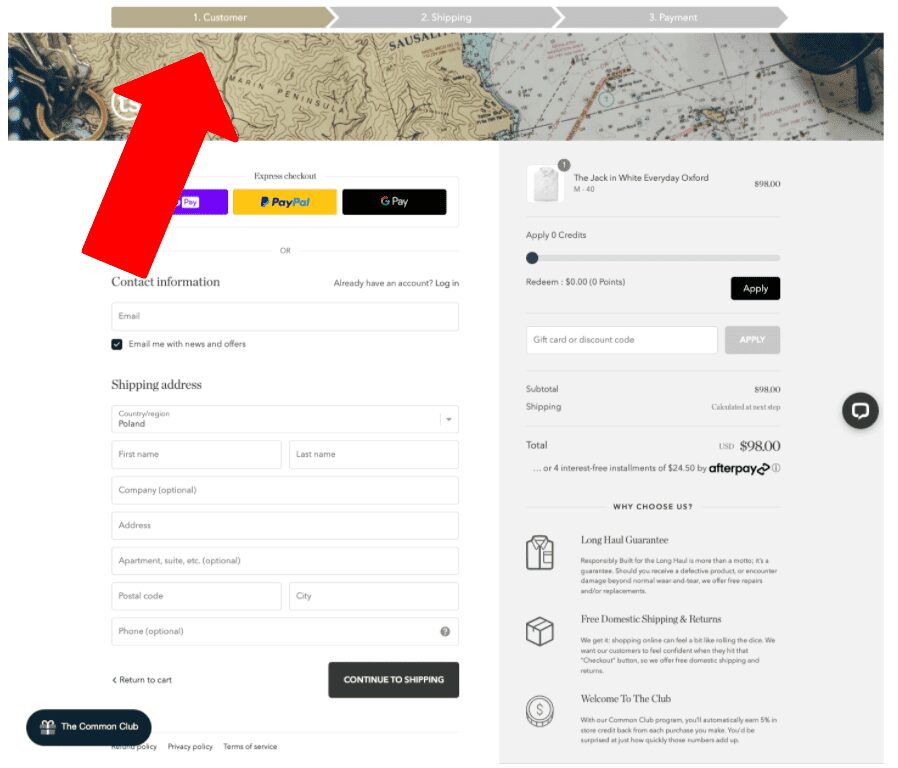
This small tweak reassures users that the end is in sight, especially on mobile where longer forms can feel tedious. Transparency is key when asking users to commit.
29. Auto-apply discounts or coupon codes to reduce drop-off
Making customers hunt for their discount codes adds friction. Auto-applying offers creates a smoother checkout, reduces drop-off, and reinforces value.
It’s especially effective during sales, promos, or new customer campaigns.
When creating an OptiMonk campaign, make sure to enable the “Auto redeem” feature. This way, the coupon code will be redeemed automatically for your visitors during checkout, ensuring they don’t forget to redeem their coupon.
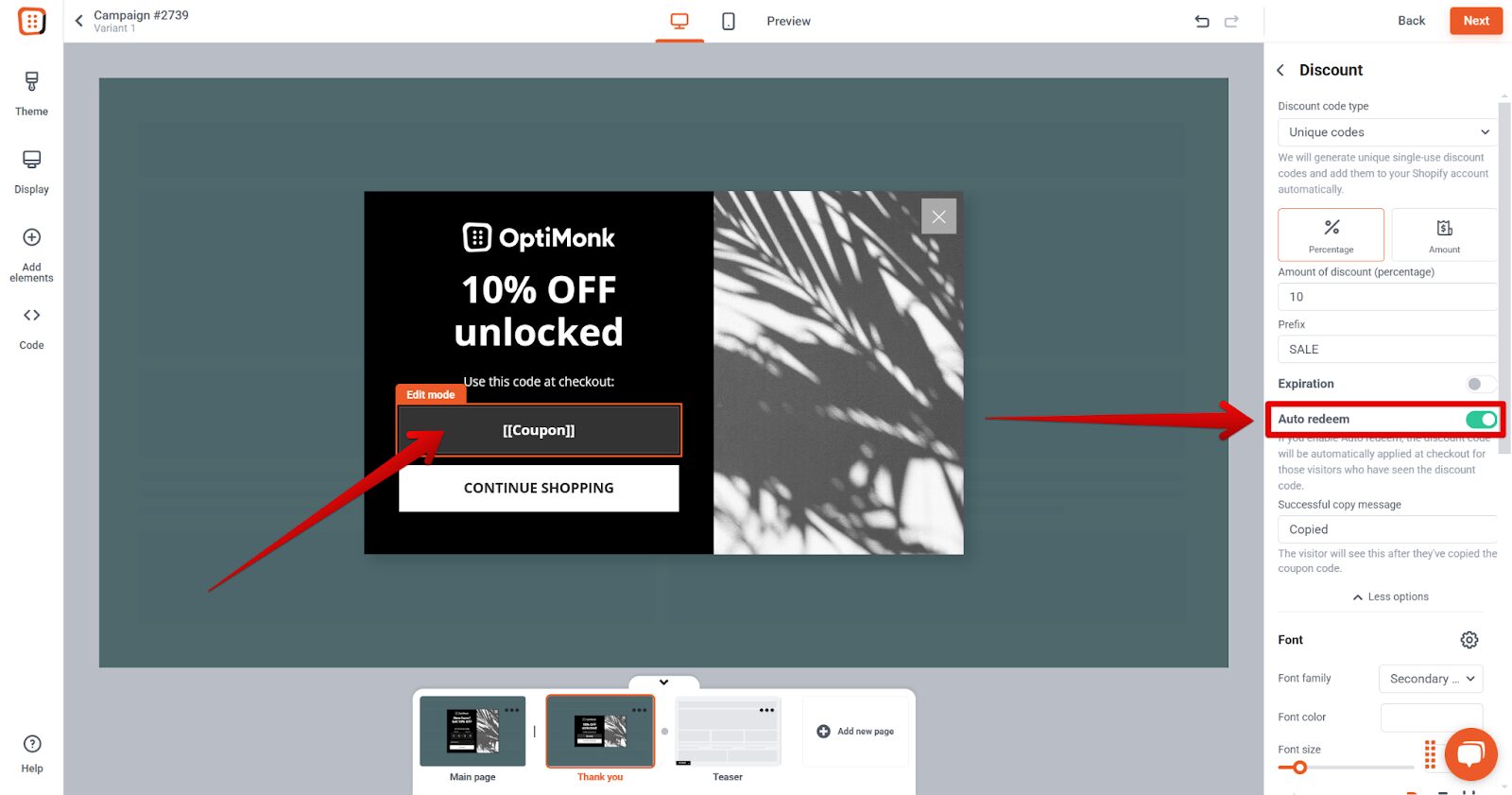
30. Add urgency elements at checkout
Scarcity and urgency are powerful motivators at the decision stage.
Phrases like “Only 2 left in stock” or countdown timers with messages like “Sale ends in 15 minutes” push users to act quickly. But these elements need to be genuine—false urgency can erode trust.
Used responsibly, they can reduce indecision and improve conversion rates at the last step. A subtle alert can be exactly the nudge someone needs to click “Buy Now” instead of “Save for later.”
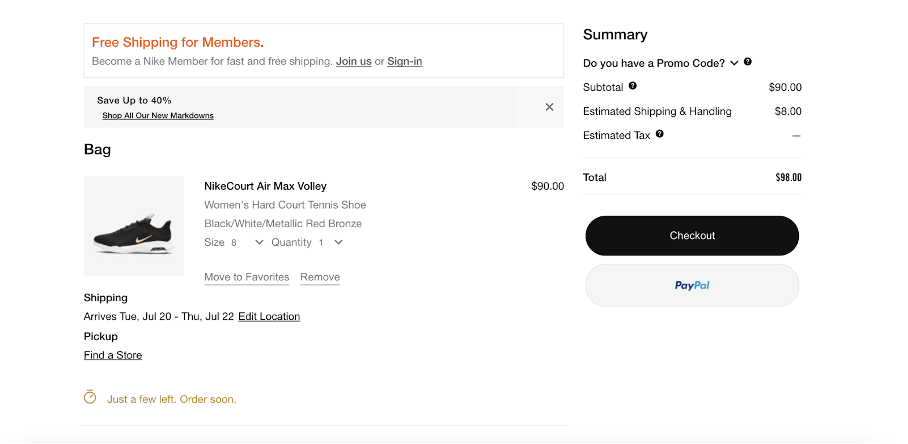
31. Personalize the homepage hero based on the user’s browsing behavior
Dynamic homepage content tailored to each visitor’s past behavior boosts relevance and engagement.
If a user previously browsed women’s running shoes, show them a banner featuring new arrivals in that category when they return.
This kind of personalization shortens the path to conversion by bringing the most relevant products front and center.
It also shows users that your store “remembers” them, which increases customer loyalty.
32. Add a sticky “Add to Cart” button on mobile
Mobile browsing often involves scrolling, which can push CTAs out of view. A sticky “Add to Cart” button ensures that users always have a clear next step, no matter how far down they go.
It improves usability and prevents potential drop-offs caused by having to scroll all the way back up.
Rare Beauty uses this effectively to keep conversions flowing smoothly on mobile.
33. Use trust badges near your CTA
Trust signals placed close to your CTA reassure users at the moment of decision. Whether it’s a “Secure Checkout” icon, a money-back guarantee, or a recognized payment partner logo, these badges reduce anxiety and hesitation.
Check out this example from Kiss My Keto, where they promote their 30-day money back guarantee on the product page right under the “Add to Cart” CTA.

Here’s another example from ASOS, where they display accepted payment trust badges in the cart:
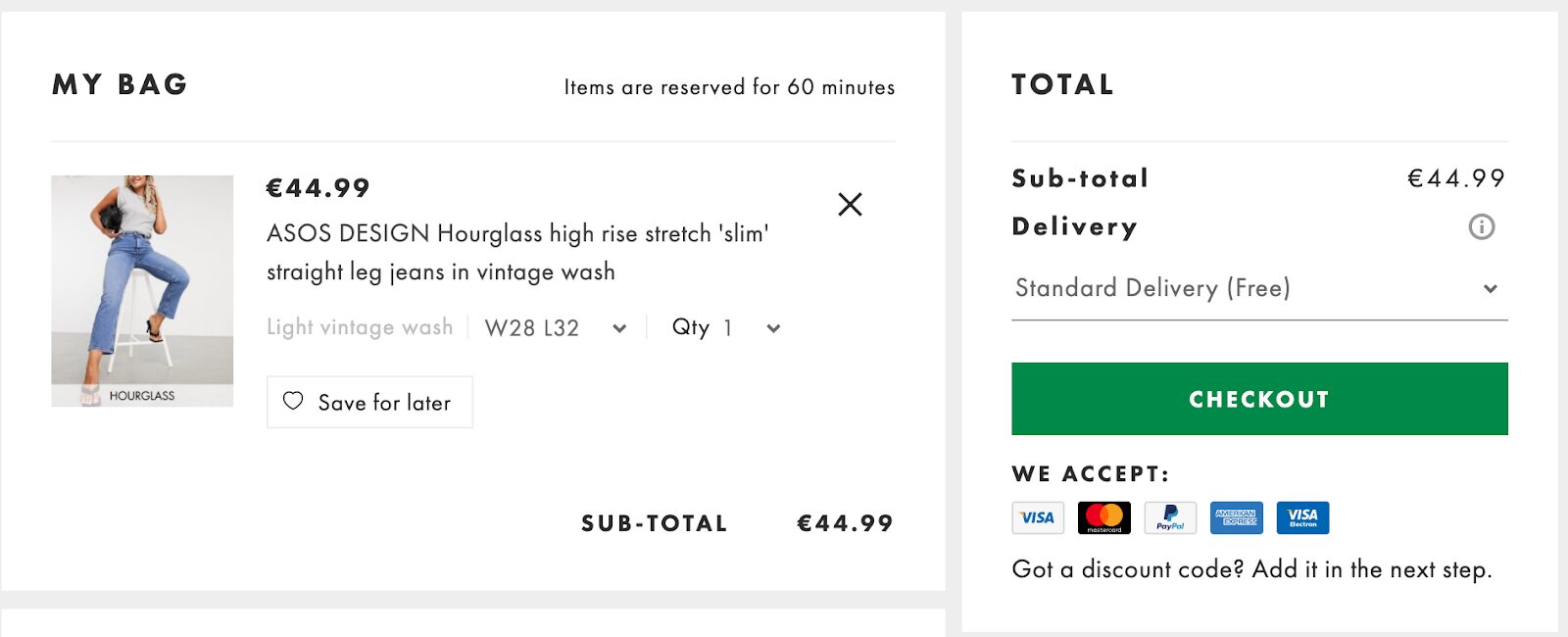
These elements signal that it’s safe to proceed and that there’s a fallback if something goes wrong. Keep them clean and visible but not overwhelming—the goal is to reassure, not clutter the experience.
34. Highlight return policy and shipping info near the “Add to cart” button
Clear return and shipping policies reduce friction by setting expectations upfront. When shoppers know returns are easy, they’re more likely to buy.
If you’d like to improve your conversions, try placing shipping info and your return policy right under the “Add to Cart” button, just like Sol de Janeiro did.

This kind of clarity builds trust and decreases hesitation.
35. Use funnel visualization in analytics to identify the biggest leaks
Funnel reports in tools like Google Analytics or Shopify tell you exactly where users are dropping off.
Whether it’s at the product page, the shipping form, or the payment screen, this visibility helps you prioritize fixes.
Rather than guessing, you can focus your optimization efforts where they’ll have the most impact. Small improvements at the biggest leak points often lead to major gains.
Think of this as your CRO roadmap, driven by real user behavior.
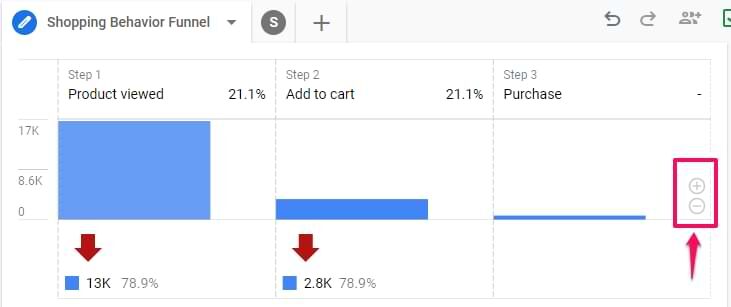
Image source: Analytics Mania
Check out this article for a detailed guide on how to use the Funnel Exploration report in Google Analytics 4.
36. Display real-time purchase notifications
Live notifications like “Mark from Chicago just bought this!” add credibility and create FOMO.
These alerts show that others are shopping now, reinforcing social proof and urgency.
When used sparingly, they add energy to your online store without feeling gimmicky.
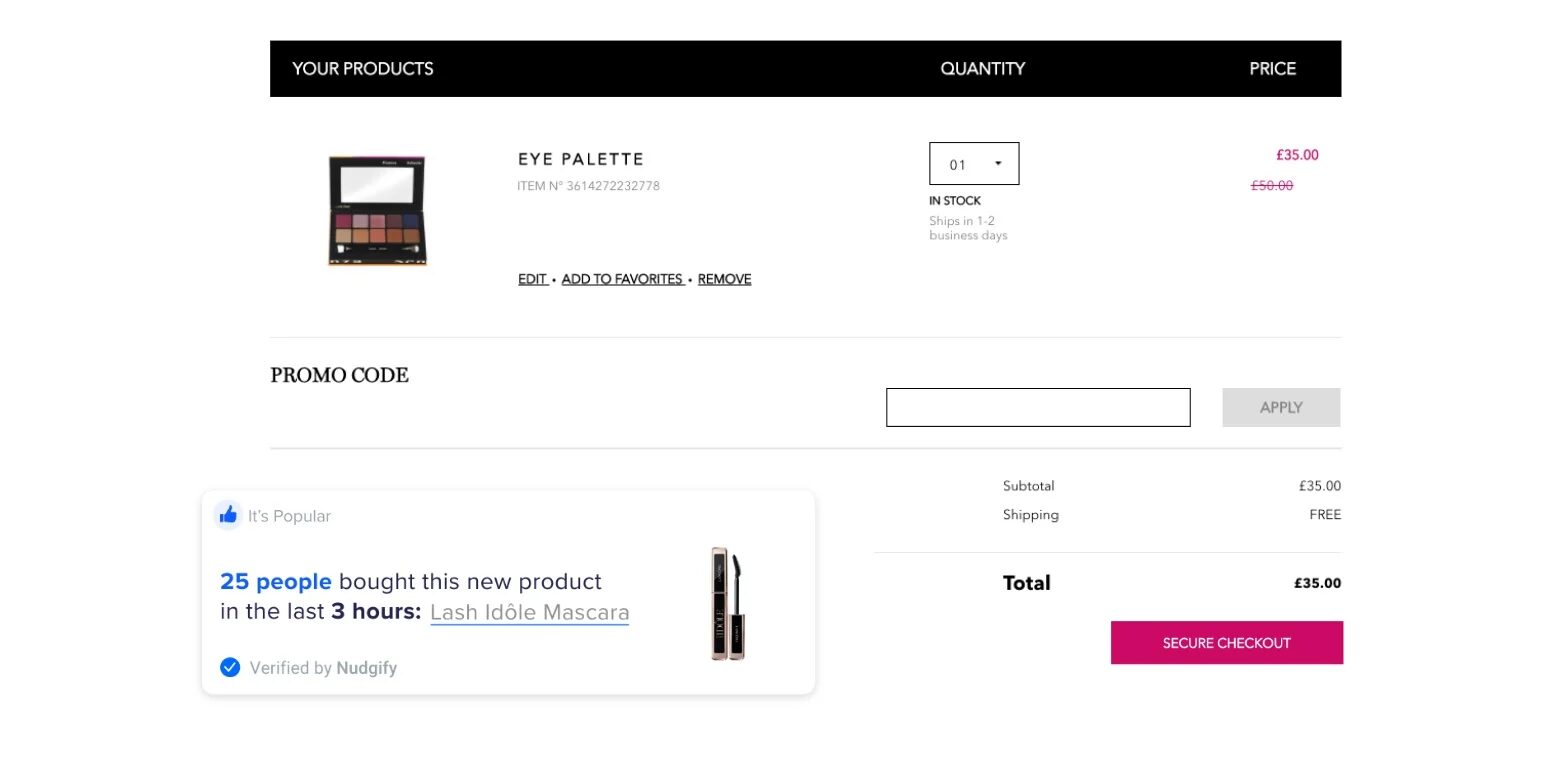
It’s a simple way to turn passive interest into active buying.
37. Add Trustpilot or third-party review badges
Featuring third-party review badges signals transparency and authenticity. When shoppers see a “4.8 stars on Trustpilot” badge, they trust that the reviews are verified and impartial.
This credibility is especially important for new visitors who aren’t yet familiar with your brand.
Badges also improve perceived professionalism and authority. For high-ticket or competitive products, this added trust layer can be the deciding factor.
38. Feature press mentions or “As seen in” logos on your homepage
Highlighting credible media mentions instantly boosts your brand authority.
Logos from publications like Forbes, TechCrunch, or Vogue act as trust transfers—if these major players trust you, shoppers are more likely to.
Casper, for instance, features prominent “As Seen In” sections:
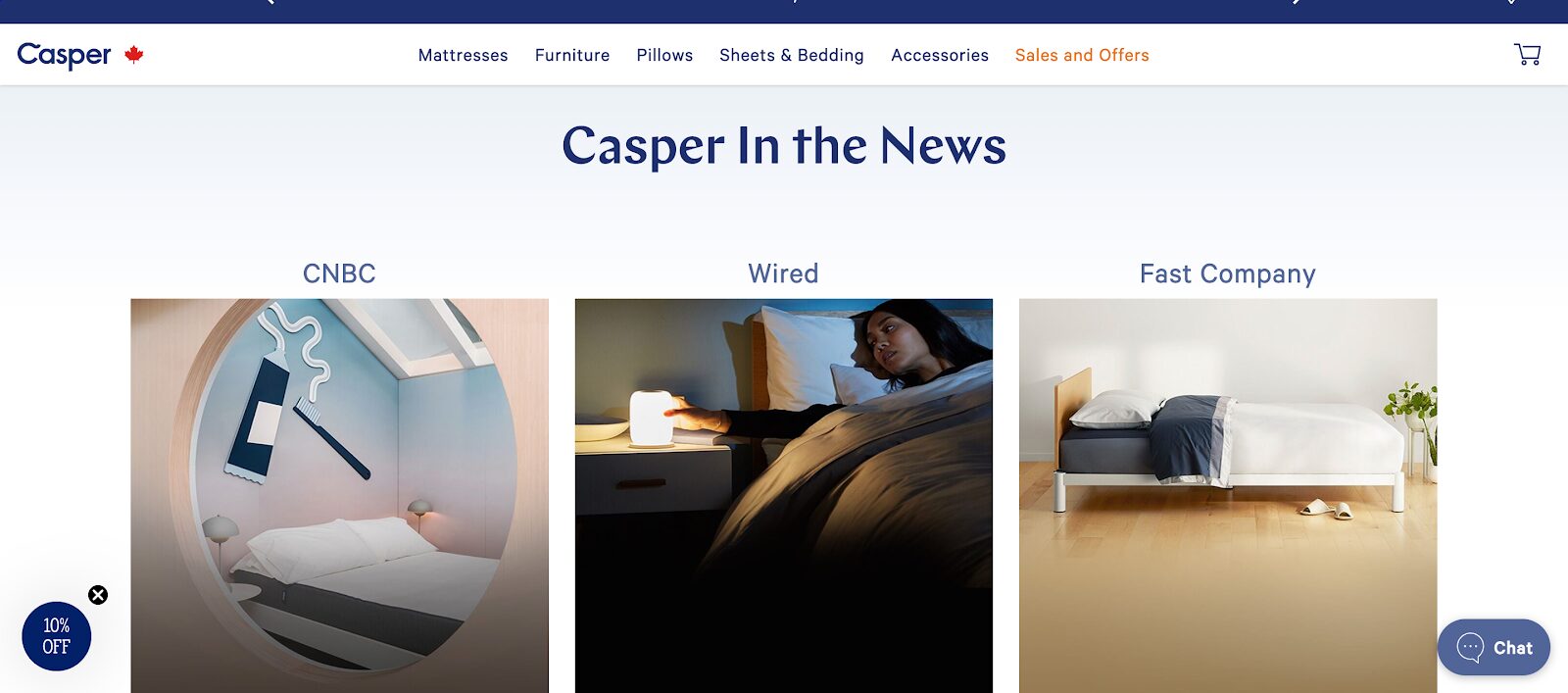
These endorsements function as third-party validation in a space where skepticism is high. Don’t be shy about showing them off.
39. Upsell after the add-to-cart event
After someone adds a product to their cart, they’re at peak buying intent. This is a great moment to offer an upsell—just make sure it’s relevant.
For example, you could suggest a premium version of the product already in the cart. Take a look at Kylie Cosmetics, who offers a lip butter when someone adds an item to their cart.

This keeps the user in flow while increasing average order value. It’s a strategic, high-conversion moment that shouldn’t be missed.
40. Set up a one-click post-purchase upsell/cross-sell
Once a customer has completed a purchase, they’re still in “buying mode.” Offering a one-click post-purchase upsell or cross-sell immediately after checkout taps into this mindset without adding friction.
These offers should be highly relevant and easy to accept—no extra payment steps required.
Think of it like “Would you like fries with that?” in digital form.
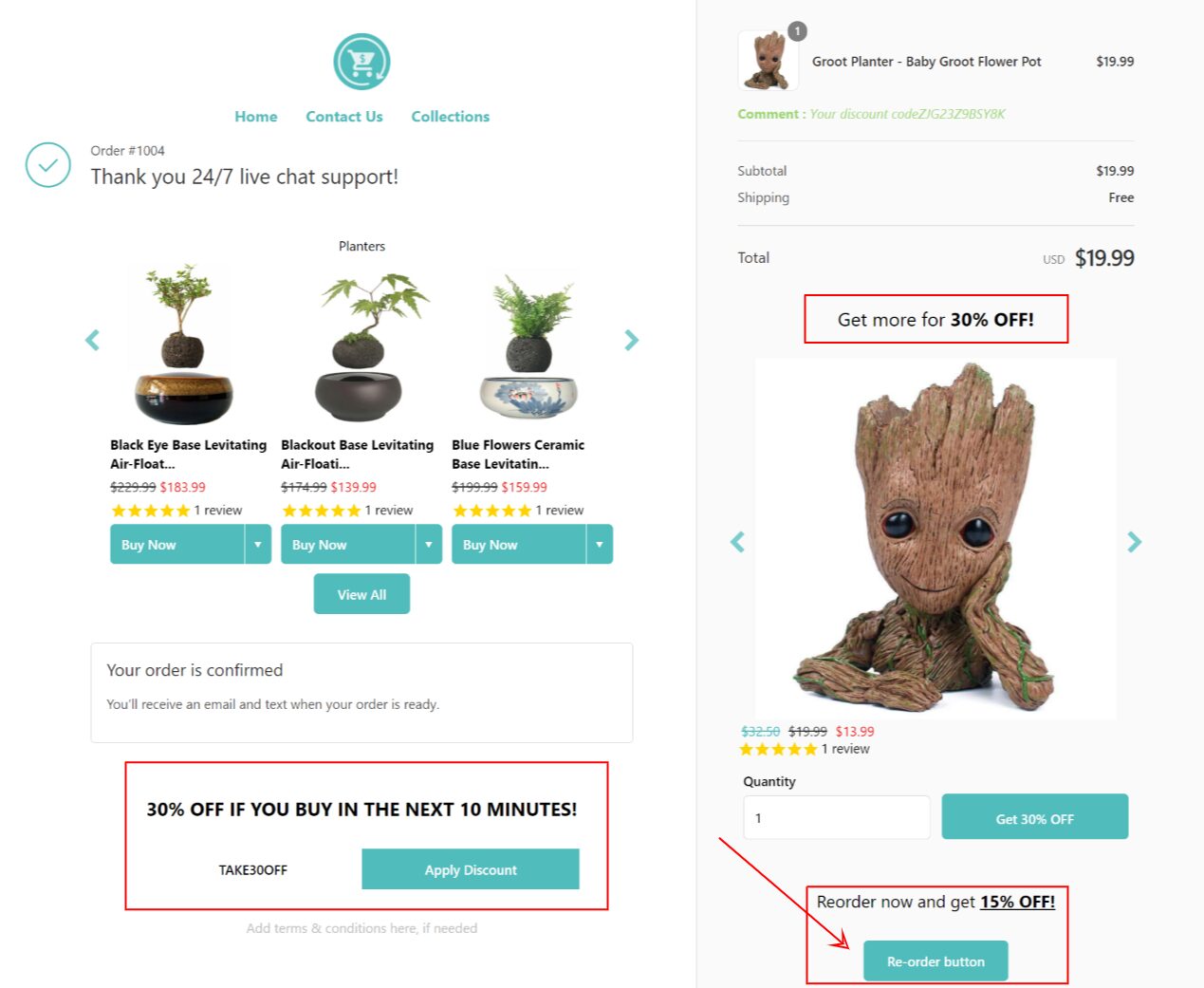
Image source: ReConvert
When implemented well, it adds revenue without impacting the user experience.
41. Send product restock notification emails
Back-in-stock emails are an easy way to recover lost sales.
Let customers opt in to be notified when an out-of-stock item returns, then follow up with a short, punchy message. These emails often have high open and click-through rates because they’re tied to existing intent.
Brands like Quince use this to re-engage eager buyers the moment inventory becomes available.

This strategy turns disappointment into opportunity—and urgency.
42. Create product bundles
Bundling related products simplifies the buying decision and provides added value.
Instead of choosing items individually, customers can grab everything they need in one click—and often at a discounted price.
Alani Nu, for instance, bundles supplements by goal (e.g., fitness or wellness), which makes selection easier and increases cart size.
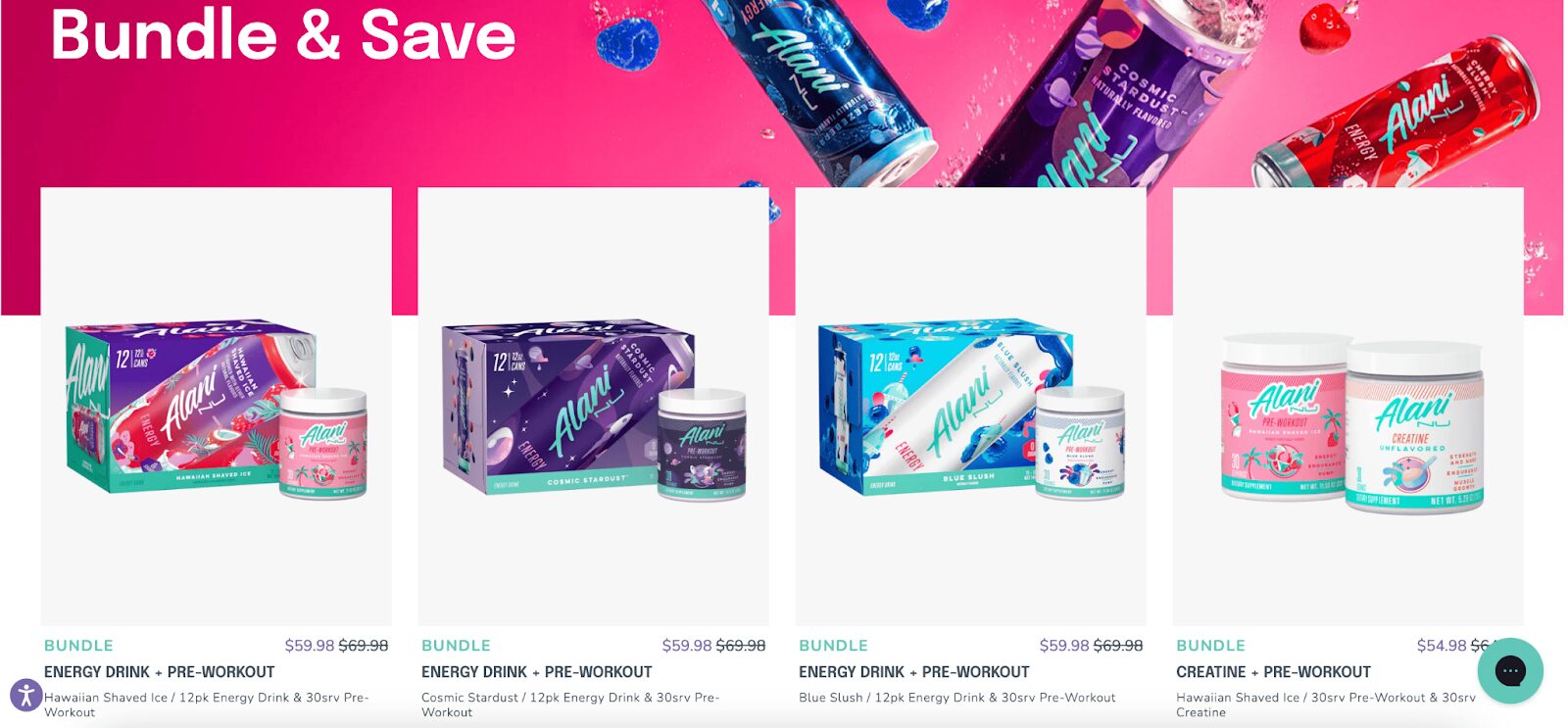
It’s a win-win: more value for the customer, more revenue for the brand. Just make sure your bundles are logically grouped and clearly communicated.
43. A/B test landing page headlines
Your headline is the first impression—and often the make-or-break moment for a conversion. If it’s not crystal clear and compelling, users won’t scroll further.
Test variations that emphasize different USPs, tones, or benefits to see what resonates most. BlendJet, for example, tested headlines like “Portable Blender”…
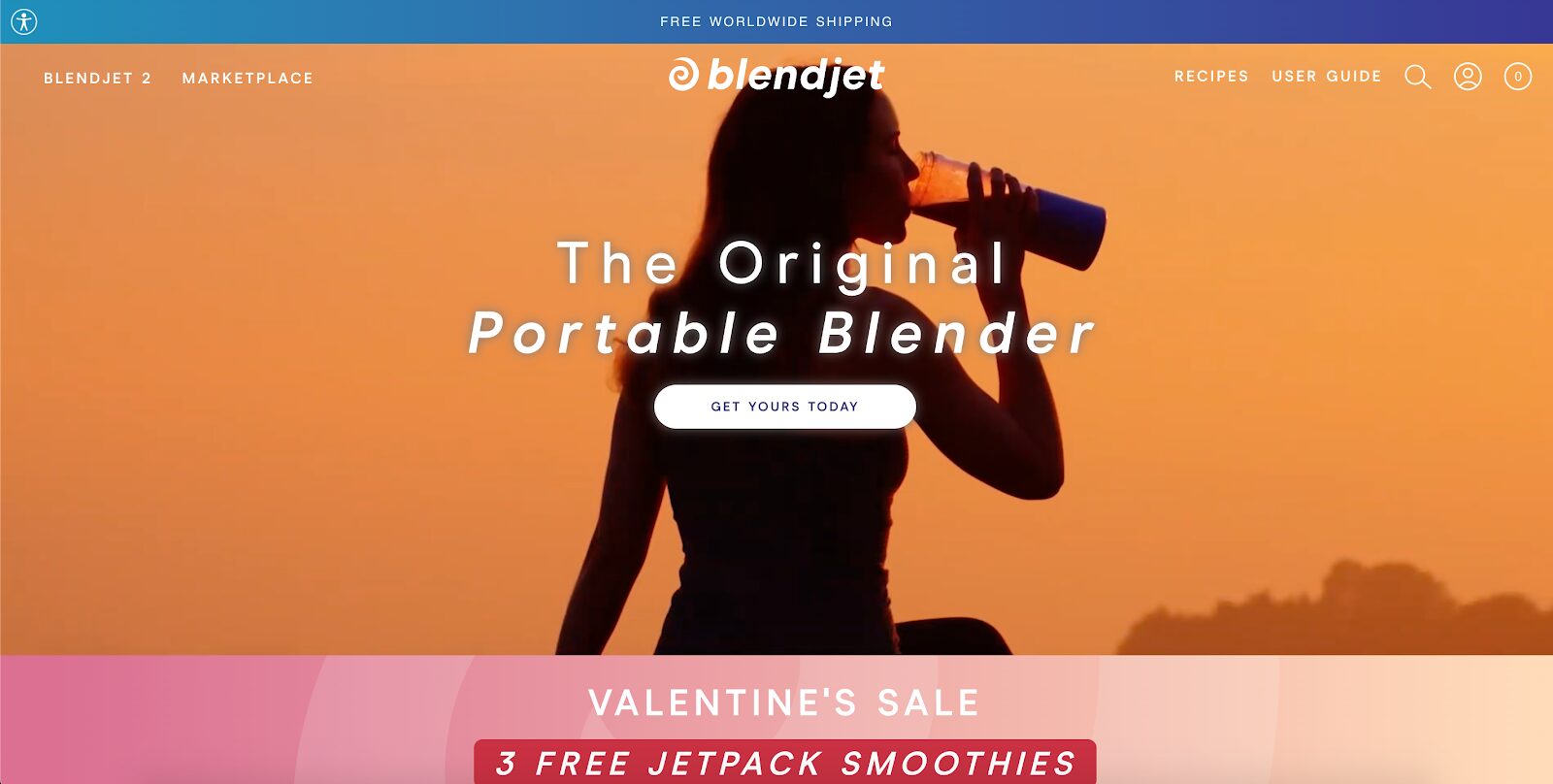
…and “Self-Cleaning Blender” to discover which message drove the most engagement.
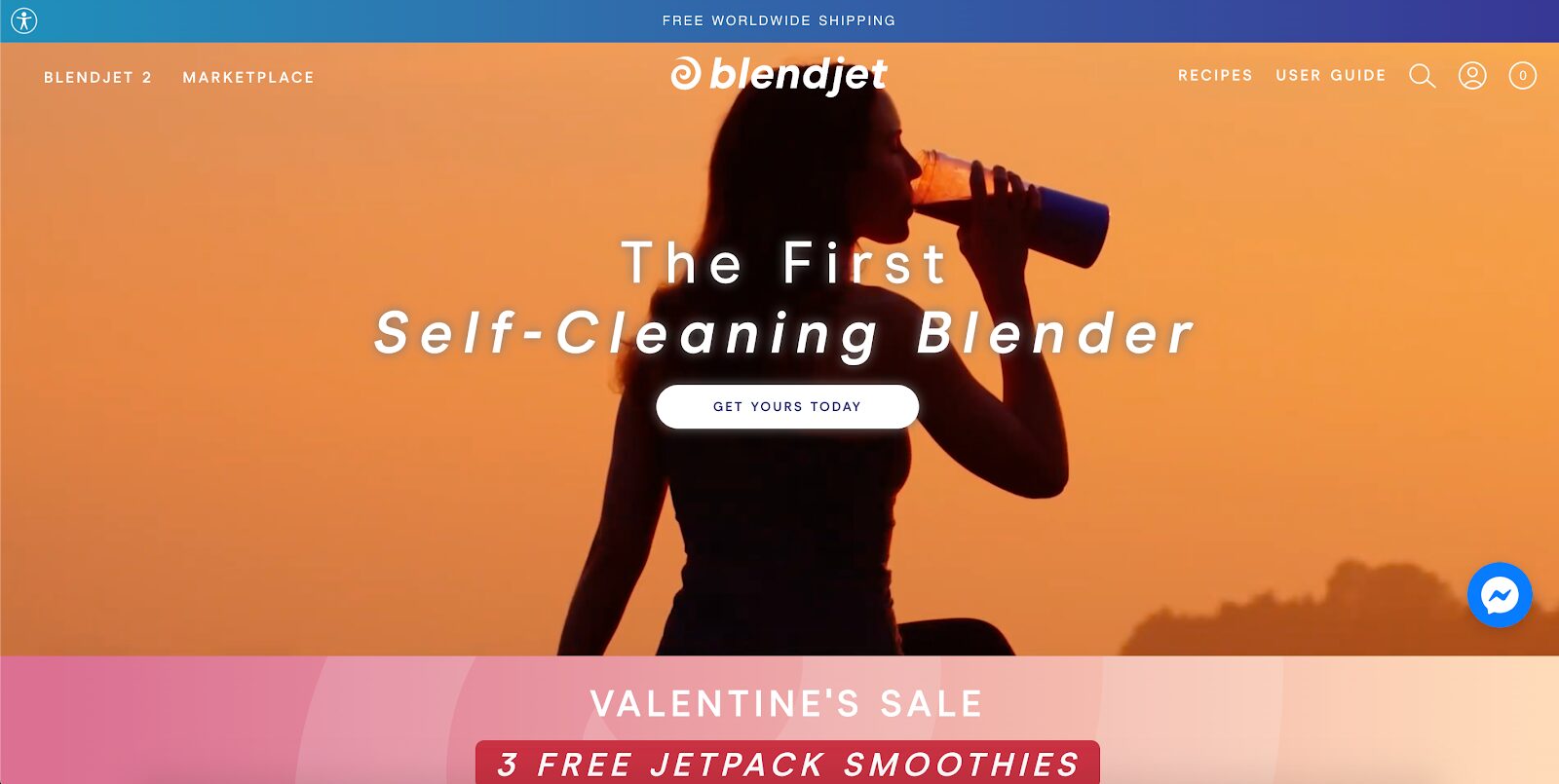
OptiMonk makes it easy to A/B test landing page headlines with its flicker-free Dynamic Content feature. Click here for a detailed step-by-step guide.
Wrapping up
Conversion rate optimization is all about using data to turn more visitors into buyers while removing friction and guiding users.
This 43-point checklist is your toolkit for testing, iterating, and scaling what works—from popups to product pages to checkout. Each tactic is designed for real, measurable impact.
Start with a few quick wins, track your results, and build from there. Small, strategic changes can drive big growth when you optimize the right way!
If you’d like to get started with an all-in-one conversion rate optimization tool, give OptiMonk a try.
Migration has never been easier
We made switching a no-brainer with our free, white-glove onboarding service so you can get started in the blink of an eye.
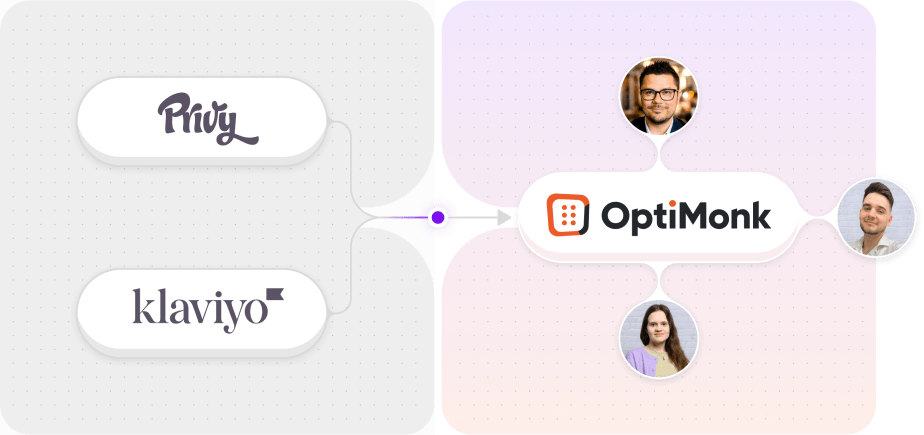
What should you do next?
Thanks for reading till the end. Here are 4 ways we can help you grow your business:
Boost conversions with proven use cases
Explore our Use Case Library, filled with actionable personalization examples and step-by-step guides to unlock your website's full potential. Check out Use Case Library
Create a free OptiMonk account
Create a free OptiMonk account and easily get started with popups and conversion rate optimization. Get OptiMonk free
Get advice from a CRO expert
Schedule a personalized discovery call with one of our experts to explore how OptiMonk can help you grow your business. Book a demo
Join our weekly newsletter
Real CRO insights & marketing tips. No fluff. Straight to your inbox. Subscribe now
Barbara Bartucz
- Posted in
- Conversion
Partner with us
- © OptiMonk. All rights reserved!
- Terms of Use
- Privacy Policy
- Cookie Policy

